If the expression of genes in the offspring directly influences their traits, the genes are transmissible from generation to generation, the genes segregate during gamete formation, and the genes of the trait segregate independently, then the genes follow ______ inheritance patterns.
Multiple choice question.
Mendelian
non-Mendelian
Mendelian
In an inheritance pattern called ____ ____, the genotype of the mother directly determines the phenotype of her offspring for a given gene.
maternal effect
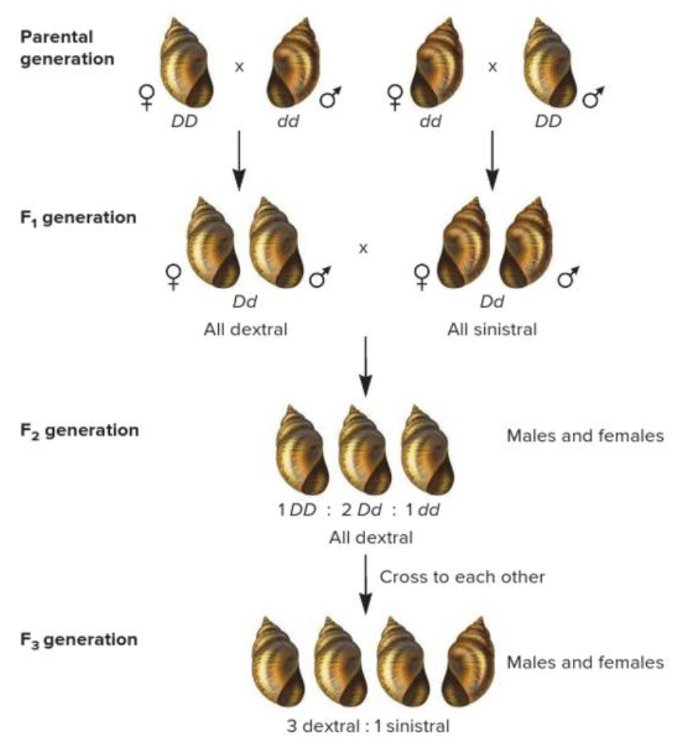
What accounts for the phenotype of the offspring in the F1 generation shown in the image?
Multiple choice question.
Paternal effect
X-linked inheritance
Codominance
Sex influenced effect
Maternal effect
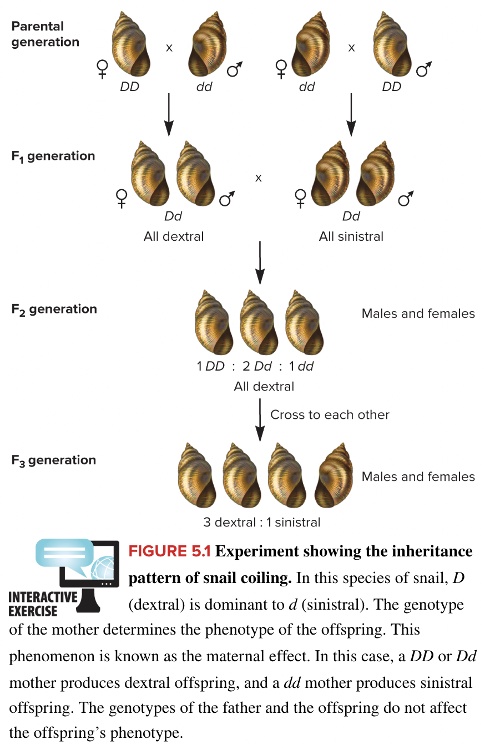
Maternal effect
Reason:
Dextral is dominant to sinistral. The genotype of the mother determines the phenotype of the offspring. This is known as maternal effect. In this case, a DD or Dd mother will produce dextral offspring and a dd mother produces sinistral offspring. The genotypes of the father and offspring do not affect the offspring's phenotype.
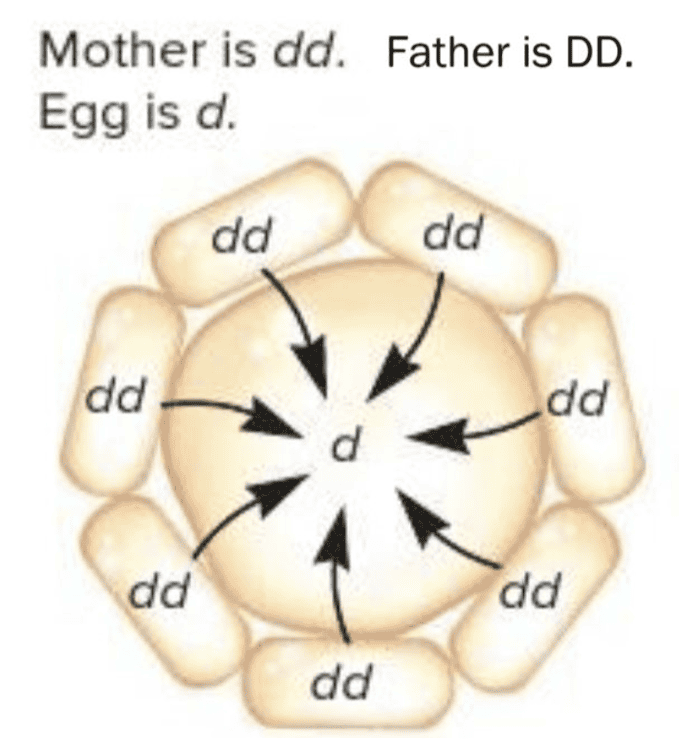
Snail shell coiling is due to a maternal effect gene with two alleles. The dominant allele D causes dextral (right-handed) shell coiling while the recessive allele d leads to sinistral (left-handed) coiling. The gene product is transferred from nurse cells into the egg as shown in the diagram for a homozygous (dd) mother. Suppose this egg is fertilized by a gamete from a dextral (DD) male. What are the expected phenotypes of the offspring?
Multiple choice question.
dextral
sinistral
both sinistral and dextral
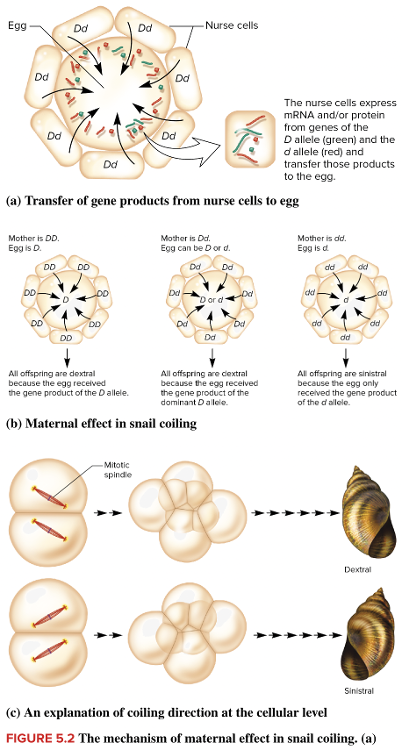
sinistral
Within the two-to four-cell snail embryo, which factor is responsible for the origin of dextral and sinistral shell coiling?
Multiple choice question.
Orientation of the mitotic spindle
Organization of proteins encoded by maternal genes
Arrangement of proteins in the plasma membrane
Location of vesicles produced by the Golgi apparatus
Orientation of the mitotic spindle
Select all that apply
Select all of these that are true of genes that follow a Mendelian inheritance pattern.
Multiple select question.
The genes are influenced by expression of maternal genes in the egg.
The genes are transmissible from generation to generation.
The genes segregate during gamete formation.
Expression of genes in the offspring directly influences their traits.
The genes segregate independently.
The genes are transmissible from generation to generation.
The genes segregate during gamete formation.
Expression of genes in the offspring directly influences their traits.
The genes segregate independently.
True or false: In Drosophila, proper anteroposterior and dorsoventral development requires a separate set of maternal effect gene products accumulating in the appropriate area of the embryo.
True
Reason:
Studies in Drosophila, mice and humans have identified several maternal effect genes that are required for proper development.
What type of inheritance accounts for the genotype of the mother being the direct determining factor in the phenotype of the offspring?
Multiple choice question.
X-linked inheritance
Sex influenced effect
Codominance
Paternal effect
Maternal effect
Maternal effect
A type of change in which a temporary alteration to a chromosome modifies gene expression but is not permanent over many generations is called ____ change.
epigenetic
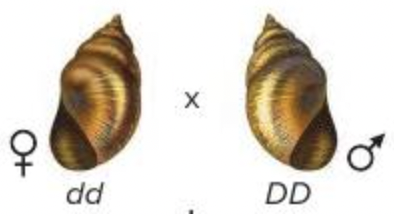
In the snail Lymnaea peregra, shell coiling is regulated by a maternal effect gene, and dextral is dominant to sinistral. What is the expected phenotype of the offspring for the cross shown in the image?
Multiple choice question.
50% sinistral : 50% dextral
100% sinistral
75% sinistral : 25% dextral
100% dextral
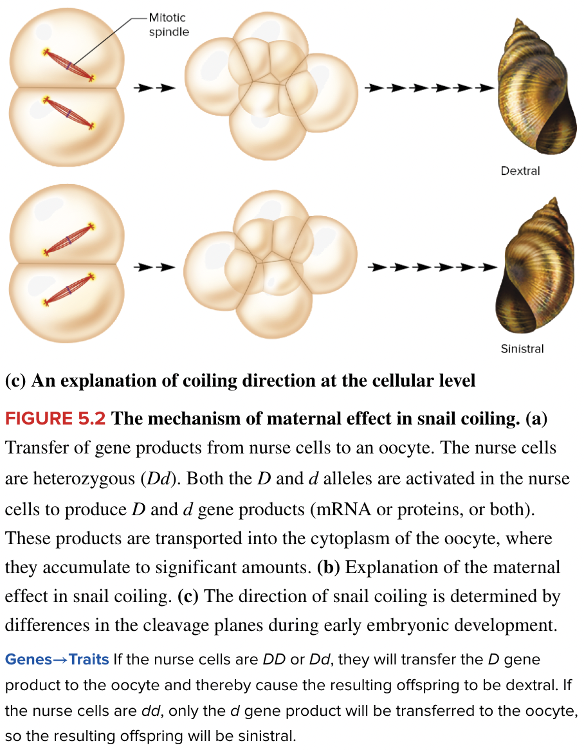
100% sinistral
Reason:
Dextral is dominant to sinistral. The genotype of the mother determines the phenotype of the offspring. This is known as maternal effect. In this case, a DD or Dd mother will produce dextral offspring and a dd mother produces sinistral offspring. The genotypes of the father and offspring do not affect the offspring's phenotype.
Despite the fact that human males are XY and human females are XX, they have equal expression of many genes on their sex chromosomes. This phenomenon is called
dosage compensation
[Blank 1: dosage, dosage compensation, X-chromosome, X, or dose
Blank 2: compensation or inactivation]
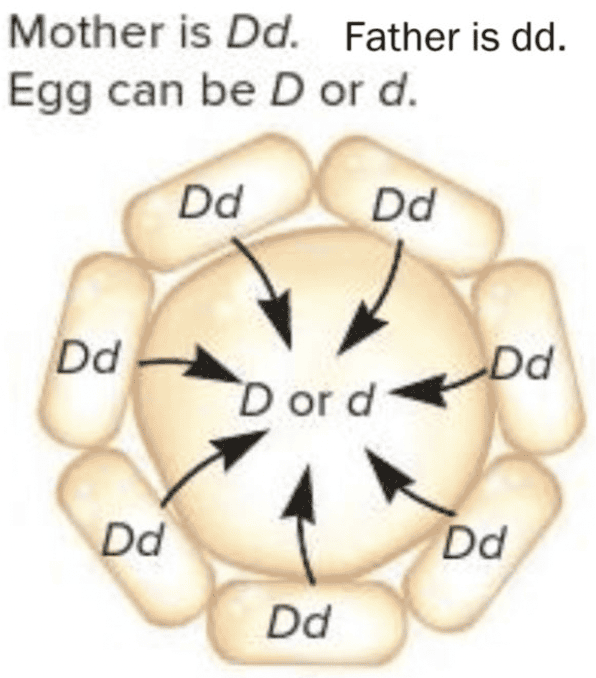
Snail shell coiling is due to a maternal effect gene with two alleles. The dominant allele D causes dextral (right-handed) shell coiling while the recessive allele d leads to sinistral (left-handed) coiling. The gene product is transferred from nurse cells into the egg as shown in the diagram for a heterozygous (Dd) mother. Suppose this egg is fertilized by a gamete from a sinistral (dd) male. What is the expected phenotype of the offspring?
Multiple choice question.
dextral if the egg has the D genotype
sinistral if the egg has the d genotype
sinistral for both the D and d genotypes in the egg
dextral for both the D and d genotypes in the egg
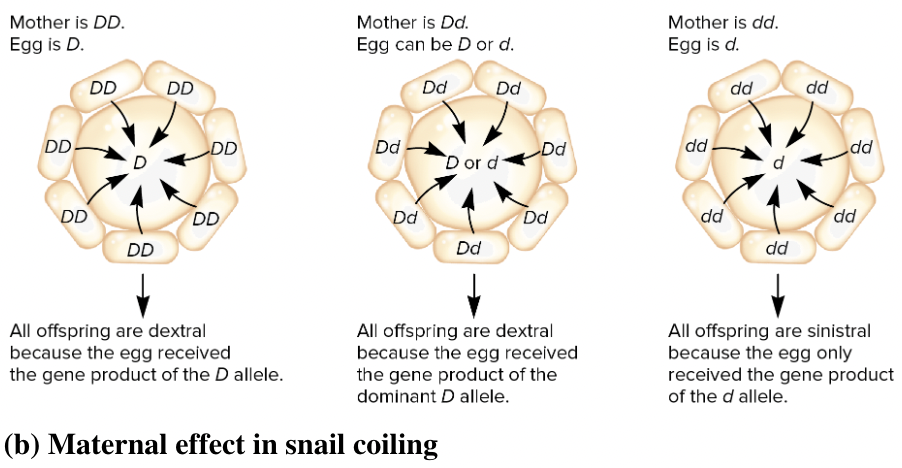
dextral for both the D and d genotypes in the egg
In somatic cells of human females one of the two X chromosomes is randomly turned off. What is this mechanism called?
Multiple choice question.
Maternal effect inheritance
Endosymbiosis
Paternal leakage
X-chromosome inactivation
X-chromosome inactivation
The origin of dextral and sinistral coiling of snail shells can be attributed to the orientation of the ____ ____ at the two- to four-cell stage of embryonic development.
mitotic spindle
In birds males are ZZ and females are ZW. Studies have shown that male birds express twice as much gene product of some Z-linked genes. What does this suggest?
Multiple choice question.
Z-linked genes are not dosage compensated in birds.
Female birds decrease Z gene expression by 50%.
One of the Z chromosomes is randomly inactivated in birds.
Z-linked genes are not dosage compensated in birds.
Reason:
The level of Z-linked gene expression should be equal if inactivation occurred.
Select all that apply
Select all of these that are influenced by maternal effect gene products.
Multiple select question.
Body axis orientation
Fertilization
Cleavage pattern
Oogenesis
Cell division
Body axis orientation
Cleavage pattern
Cell division
Which species achieves dosage compensation by increasing the expression of genes on the X chromosome in males by twofold?
Multiple choice question.
Drosophila melanogaster
Humans
Marsupial mammals
Caenorhabditis elegans
Drosophila melanogaster
Reason:
In humans, either the maternal or paternal X chromosome is randomly inactivated in somatic cells of females.
Reason:
Marsupial mammals achieve dosage compensation by inactivating the paternally derived X chromosome in all somatic cells of a female.
Reason:
In Caenorhabditis elegans, the level of expression on both X chromosomes in hermaphrodites is decreased to 50% levels compared with males.
True or false: Epigenetic changes to a chromosome are permanent modifications that remain over the lifetime and later generations of the organism.
False
Reason:
Epigenetic changes to a chromosome modify the chromosome during oogenesis, spermatogenesis or embryogenesis, but are not permanent over the course of many generations.
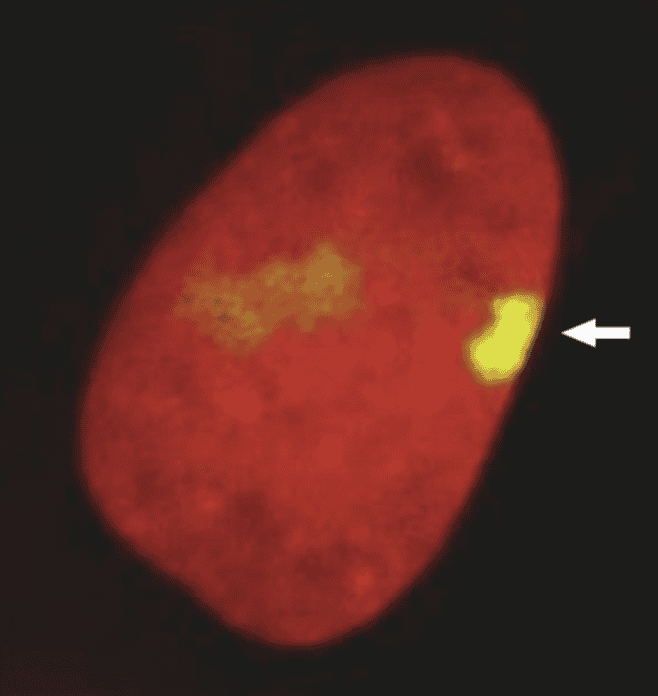
The inactivated X chromosome in somatic cells of mammals, like the one shown by the arrow in this image, is called a
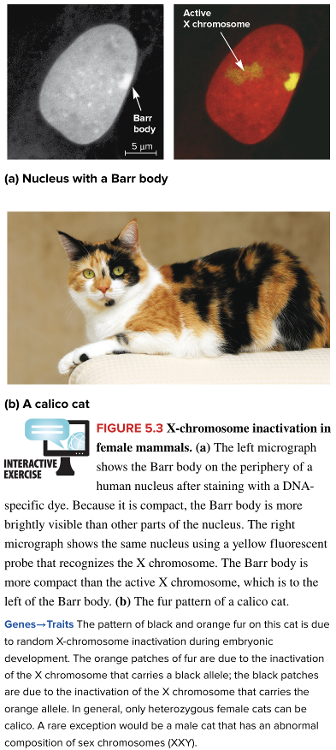
Barr body
What accounts for equal expression of genes on the sex chromosomes despite the fact that males and females have an unequal complement of sex chromosomes?
Multiple choice question.
Sex influenced inheritance
Sex limited inheritance
Maternal effect
Dosage compensation
Dosage compensation
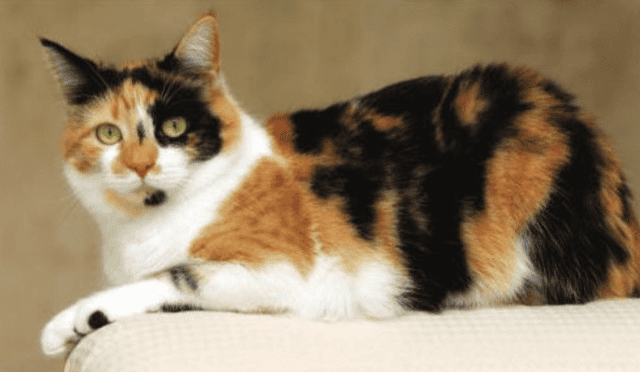
The coat color of the calico cat shown in the image is best explained by ______.
Multiple choice question.
maternal effect
paternal effect
codominance
the Lyon hypothesis
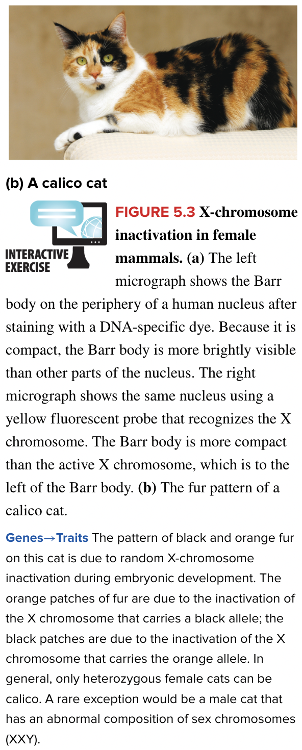
the Lyon hypothesis
Reason:
X chromosome inactivation is a random process that occurs early on in development. This is what accounts for the variegated phenotype.
In humans with a typical constitution of chromosomes, X-chromosome inactivation induces dosage compensation by randomly inactivating one of the X chromosomes in the somatic cells of ______.
Multiple choice question.
both males and females
males
females
females
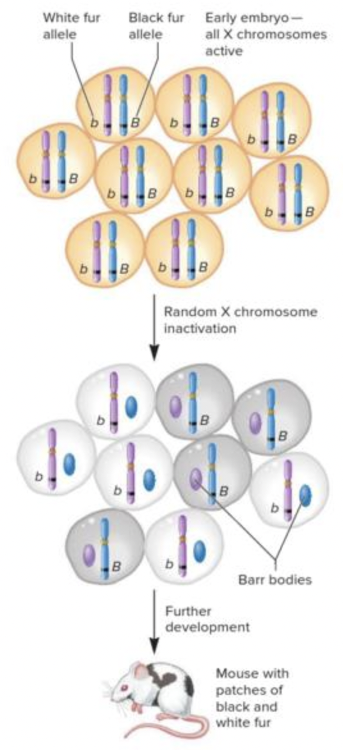
The image is depicting the mechanism of X-chromosome inactivation, called the ______.
Multiple choice question.
genomic imprinting
maternal effect
theory of independent assortment
Lyon hypothesis

Lyon hypothesis
True or false: Like X chromosomes in human females, one of the Z chromosomes in female birds is randomly inactivated in somatic cells.
False
Reason:
Studies suggest that some Z-linked genes may be dosage compensated, but many are not. Male birds have two similar sex chromosomes.
Which statement best describes how X chromosomes are inactivated in female mammals?
Multiple choice question.
The same X is inactivated in each gamete.
The same X is inactivated in all cells at an early stage of embryonic development.
One X is randomly inactivated in each cell at an early stage of embryonic development.
One X is randomly inactivated in each gamete.
One X is randomly inactivated in each cell at an early stage of embryonic development.
Reason:
The inactivation process is random, either of the two X chromosomes in a given cell can be inactivated.
Which species achieves dosage compensation by inactivating the paternally derived X chromosome in all somatic cells of a female?
Multiple choice question.
Drosophila melanogaster
Humans
Caenorhabditis elegans
Marsupial mammals
Marsupial mammals
Reason:
In Drosophila melanogaster, the level of expression of genes on the X chromosome in males is increased twofold.
Reason:
In humans, either the maternal or paternal X chromosome is randomly inactivated in somatic cells of females.
Reason:
In Caenorhabditis elegans, the level of expression on both X chromosomes in hermaphrodites is decreased to 50% levels compared with males.
In the experiment carried out by Davidson, Nitowsky, and Childs, which outcome would support the Lyon hypothesis?
Multiple choice question.
All nine clones expressed the slow G-6-PD protein.
All nine clones expressed either the fast or slow G-6-PD protein but not both.
All nine clones expressed both the fast and slow G-6-PD proteins.
All nine clones expressed the fast G-6-PD protein.
All nine clones expressed either the fast or slow G-6-PD protein but not both.
Reason:
One of the genes would be inactivated so both protein forms would not be expressed.
What is a Barr body?
Multiple choice question.
An inactivated X chromosome in mammalian somatic cells
An inactivated autosome in mammalian somatic cells
An inactivated Y chromosome in mammalian somatic cells
An inactivated X chromosome in mammalian somatic cells
Population of cells that are all derived from a single cell are called
clones
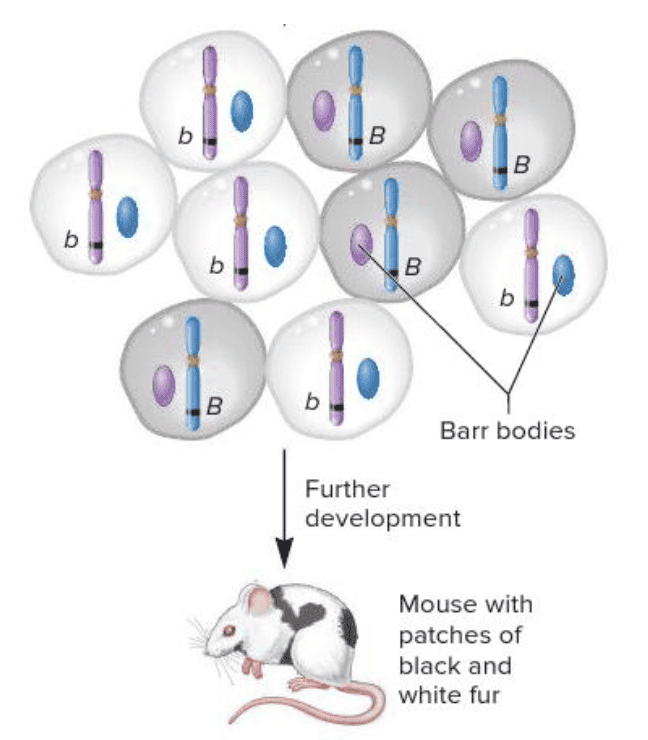
As shown in the image, X chromosomes are randomly inactivated during embryonic development. This is also called ______.
Multiple choice question.
codominance
the Lyon hypothesis
paternal effect
maternal effect

the Lyon hypothesis
A male with Klinefelter syndrome (XXY) would have how many Barr bodies in his cells?
Multiple choice question.
One
Two
Three
None
One
Reason:
The number of Barr bodies is equal to the number of X chromosomes minus one.
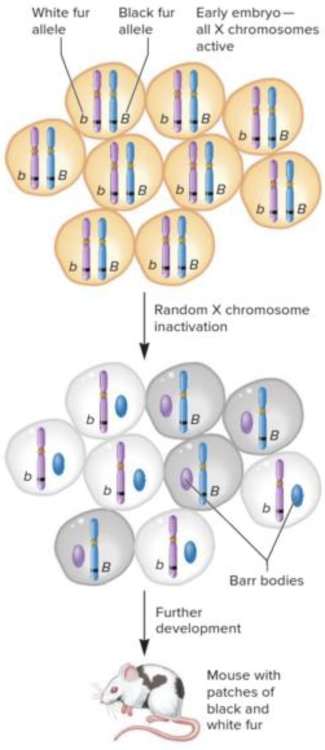
Fill in the blank question.
The mechanism of X-chromosome inactivation (shown in the figure) is known as the ____ hypothesis.

Lyon
The short region on the X chromosome that plays an important role in X chromosome inactivation is the ____. (Use an abbreviation.)
Xic
What happens to the inactivated X chromosome in female mammals when cells divide?
Multiple choice question.
The inactivated X chromosome is passed along to all future somatic cells.
The inactivated X chromosome decondenses and one of the two X chromosomes is randomly inactivated in each somatic daughter cell.
The inactivated X chromosome stays inactivated in both somatic cells and gametes.
The inactivated X chromosome is passed along to all future somatic cells.
Reason:
The pattern of inactivation is passed along during somatic cell division.
Reason:
Inactivation occurs in somatic cells.
Select all that apply
Select all of these that are phases of X chromosome inactivation.
Multiple select question.
Nucleation
Spreading
Maintenance
Termination
Elongation
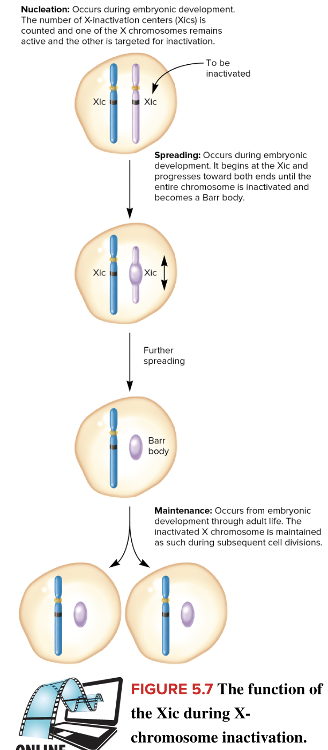
Nucleation
Spreading
Maintenance
For the experiment testing the Lyon hypothesis at the cellular level carried out by Davidson, Nitowsky, and Childs, the individual who donated the cells must have been a ______ for the gene of interest.
Multiple choice question.
male homozygous
female heterozygous
male heterozygous
female homozygous
female heterozygous
Reason:
Only heterozygotes can show which gene is inactivated, either for the slow or fast form of the protein.
Select all that apply
Which phases of X chromosome inactivation occur only during embryonic development?
Multiple select question.
Maintenance
Nucleation
Spreading
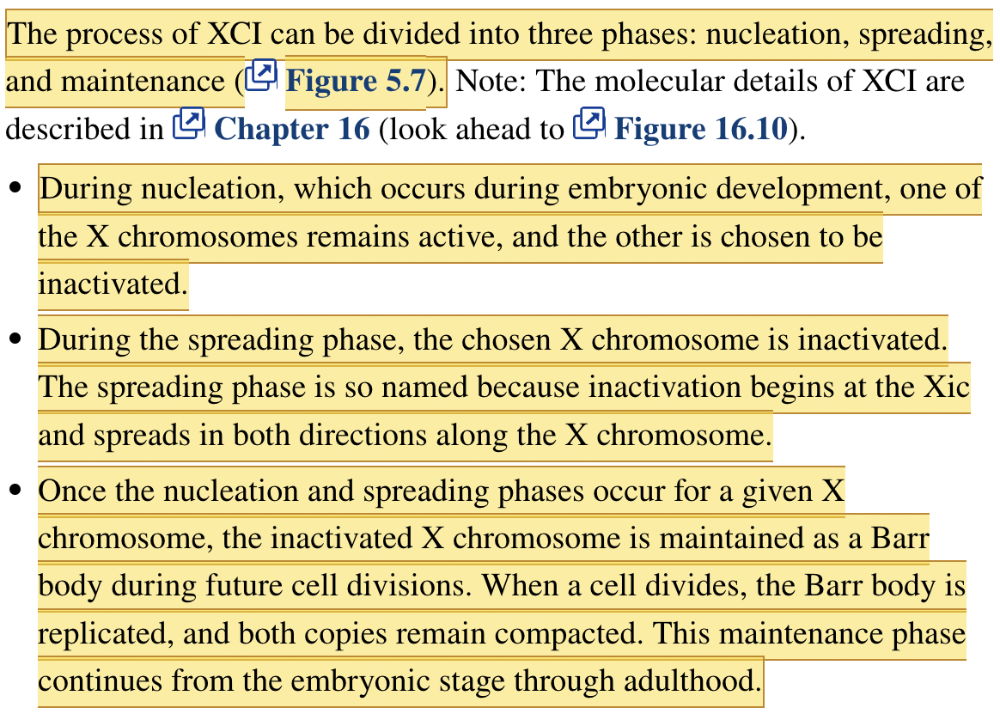
Nucleation
Spreading
Reason:
Maintenance occurs from embryonic development throughout life to preserve the state of X chromosome inactivation.
Which of these best describes a clone?
Multiple choice question.
A population of cells derived from a single cell
Oocytes fertilized by the same sperm donor
Gametes produced by meiosis
A population of cells derived from a single cell
Select all that apply
A person who has somatic cells with two Barr bodies could have which of the following genotypes?
Multiple select question.
XXY
XXX
XXXY
XO
XYY
XXX
XXXY
True or false: All genes on the inactivated X chromosome remain inactivated throughout life in a somatic cell of an adult female.
False
Reason:
Some genes on the inactivated X chromosome are expressed in the somatic cells of adult female mammals.
What is the primary role of the X-inactivation center (Xic)?
Multiple choice question.
Expression of genes on the X chromosome
X-chromosome inactivation
Expression of female secondary characteristics
X-chromosome inactivation
N: Xic = X-inactivation center
What are the three phases of X chromosome inactivation?
Multiple choice question.
Initiation, elongation, and termination
Denaturation, annealing and elongation
Nucleation, spreading, and maintenance
Replication, transcription and translation
Nucleation, spreading, and maintenance
During which phase of X chromosome inactivation is one of the X chromosomes chosen to be inactivated?
Multiple choice question.
Spreading
Maintenance
Nucleation
Nucleation
Reason:
The X chromosome is targeted for inactivation during the initiation phase. The actual inactivation occurs during the spreading phase.
What is genomic imprinting?
Multiple choice question.
A form of inheritance in which organellar genetic material influences gene expression
A form of epigenetic inheritance in which a segment of DNA is marked in a way that it alters gene expression
The expression of genes based on inheritance through the cytoplasm of the egg
The inactivation of an X chromosome by Xist gene RNAs
A form of epigenetic inheritance in which a segment of DNA is marked in a way that it alters gene expression
Reason:
Genomic imprinting refers to a situation in which a segment of DNA is marked before fertilization, and that mark is retained and recognized throughout the life of the organism inheriting the marked DNA.
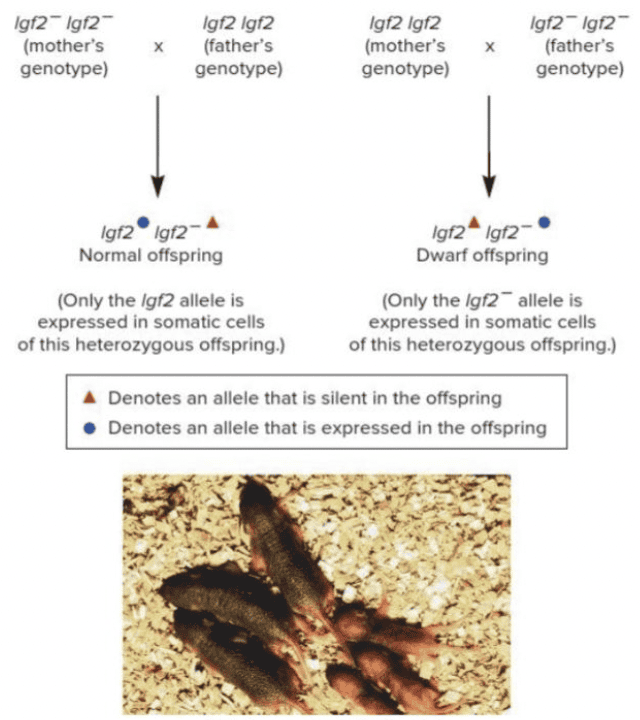
The mice in the figure are heterozygous, Igf2 Igf2 -, yet they have different phenotypes due to genomic imprinting. What is this phenomenon called?
Multiple choice question.
Codominance
Monoallelic expression
Variable expression
Incomplete dominance
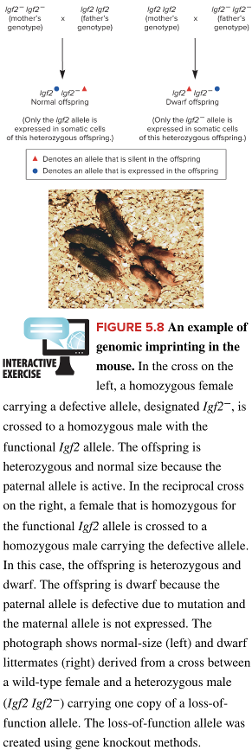
Monoallelic expression
Which genes on the X chromosome are able to escape the effects of X chromosome inactivation in female mammalian cells?
Multiple choice question.
FoxP3 gene
SRY gene
Pseudoautosomal genes
Paternal effect genes
AZF1 gene
Pseudoautosomal genes
In the case of the Igf2 gene, which copy is expressed in the offspring?
Multiple choice question.
The allele from the father
Both alleles
It can be either the allele from the mother or the father, depending on which is imprinted.
The allele from the mother
The allele from the father
Reason:
Imprinting only occurs for the paternal Igf2 allele.
Patterns of imprinting are maintained in what type of cells throughout development?
Multiple choice question.
Somatic
Germ-line
Somatic
Select all that apply
Select all of the true statements regarding genomic imprinting.
Multiple select question.
The marking of alleles cannot be altered from generation to generation.
Genomic imprinting is permanent in somatic cells.
The marking of alleles can be altered from generation to generation.
Genomic imprinting is temporary in somatic cells.
Genomic imprinting is permanent in somatic cells.
The marking of alleles can be altered from generation to generation.
Reason:
Imprinting can be changed in the production of sex cells.
In a form of epigenetic inheritance called ____ ____, a segment of nuclear DNA is marked in a non-permanent way that alters gene expression throughout the life of the individual.
genomic imprinting
At the molecular level, one way genomic imprinting is regulated is by DNA
methylation
Even though offspring receive two alleles, one maternal and one paternal, during genomic imprinting only one allele is expressed. What is this phenomenon called?
Multiple choice question.
Codominance
Monoallelic expression
Variable expression
Incomplete dominance
Monoallelic expression
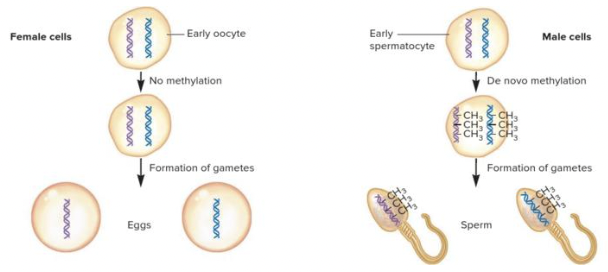
Based on the information in the figure,will the paternal or maternal chromosome be active in the resulting zygote?
Multiple choice question.
Maternal
Paternal
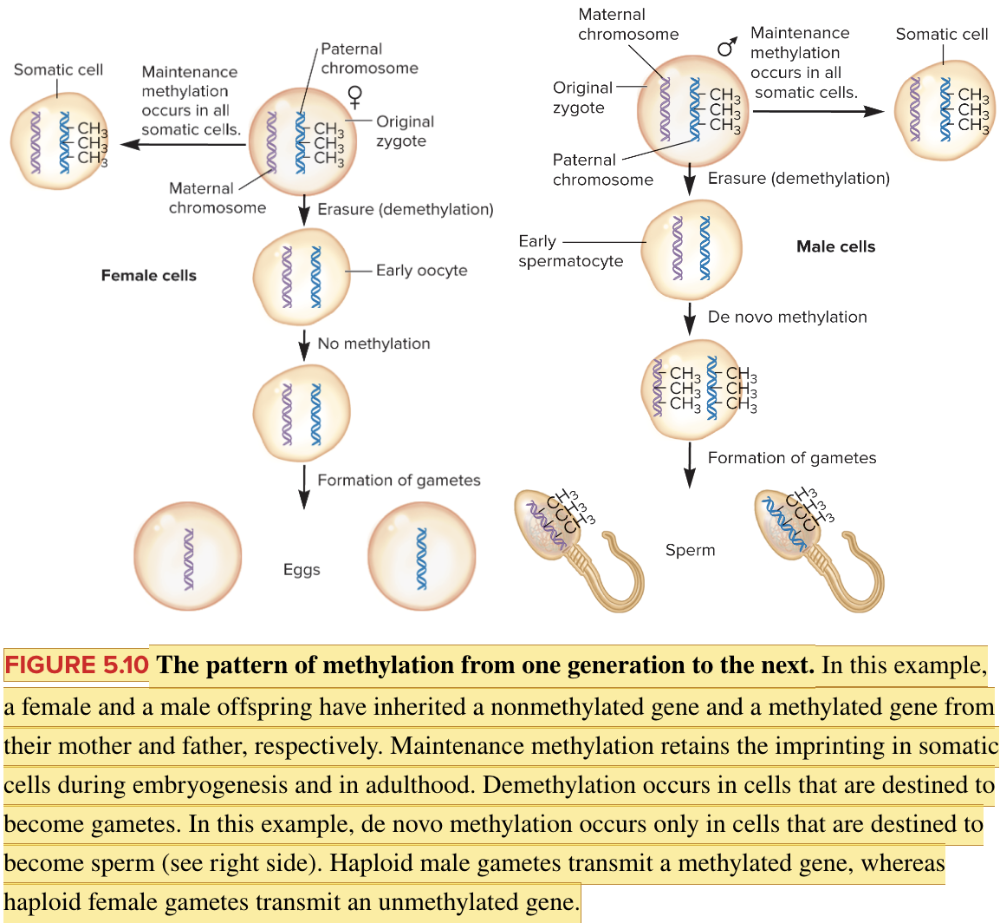
Maternal
Reason:
The DNA in the sperm has been imprinted by DNA methylation and will therefore be silenced.
Select all that apply
What information do you need to predict an offspring's phenotype when considering imprinted genes?
Multiple select question.
Which allele was inherited from which parent
The genotypes of the offspring's siblings
Which allele is on the Barr body of the female parent
If the offspring expresses the allele that is inherited from the mother or the father
Which allele was inherited from which parent
If the offspring expresses the allele that is inherited from the mother or the father
Match each stage of genomic imprinting with the correct description.
Establishment of the imprint
Maintenance of the imprint
Erasure and reestablishment of the imprint
The imprint is removed in germline cells
During gametogenesis either maternal or paternal allele is silenced and the other is expressed
The imprint pattern is continued throughout development in somatic cells
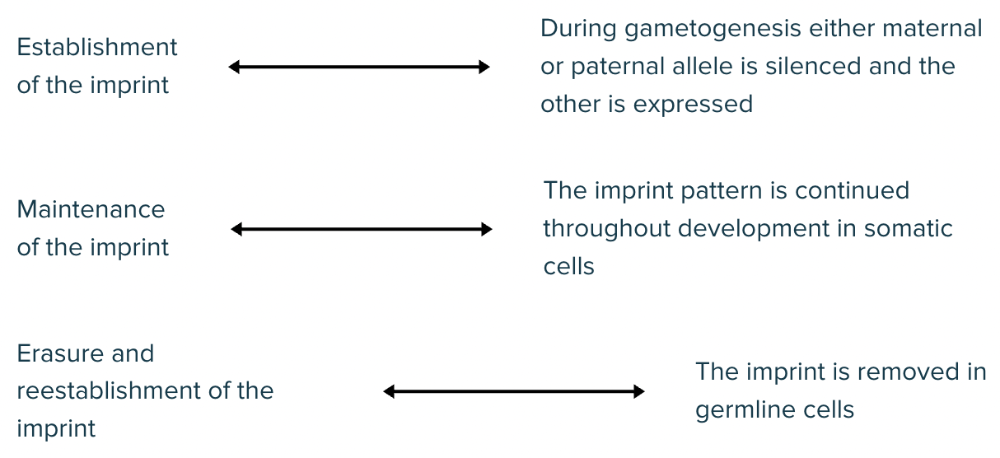
- Establishment of the imprint During gametogenesis either maternal or paternal allele is silenced and the other is expressed
- Maintenance of the imprint The imprint pattern is continued throughout development in somatic cells
- Erasure and reestablishment of the imprint The imprint is removed in germline cells
Select all that apply
Select all of these that are human diseases caused by genomic imprinting.
Multiple select question.
Angelman syndrome
Leber hereditary optic neuropathy
Mitochondrial myopathy
Prader-Willi syndrome
Angelman syndrome
Prader-Willi syndrome
In a somatic cell, the genomic imprint is _____.
Multiple choice question.
temporary
permanent
permanent
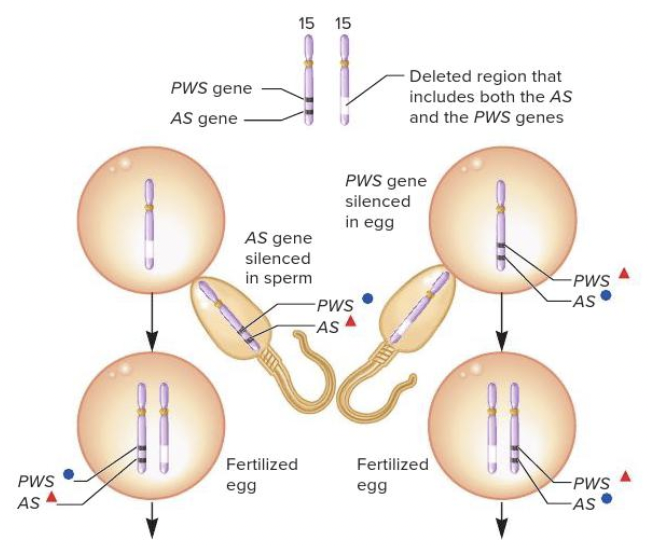
Based on the genomic imprints in the figure, the fertilized egg on the right will have which genetic disease?
Multiple choice question.
Angelman syndrome
Prader-Willi syndrome
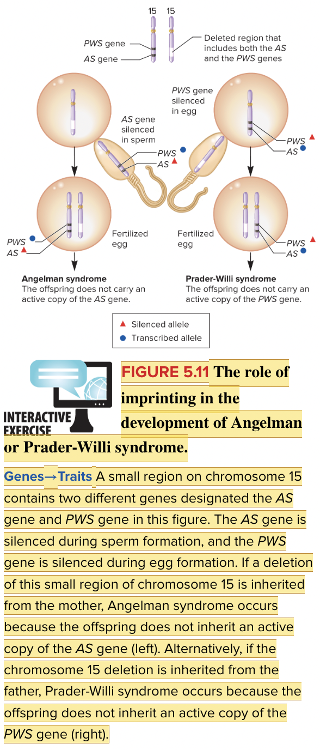
Prader-Willi syndrome
Reason:
If a chromosome 15 deletion is inherited from the father, Prader-Willi syndrome occurs because the offspring does not inherit an active copy of the PWS gene.
The regulation of a genomic imprint involves ______ near the imprinted gene.
Multiple choice question.
an imprinting control region
an origin of replication
a promoter region
a start codon
an imprinting control region
For Angelman syndrome, which gene is lacking in expression?
Multiple choice question.
snoRNA genes
UBE3A
NDN
SNRPN
UBE3A
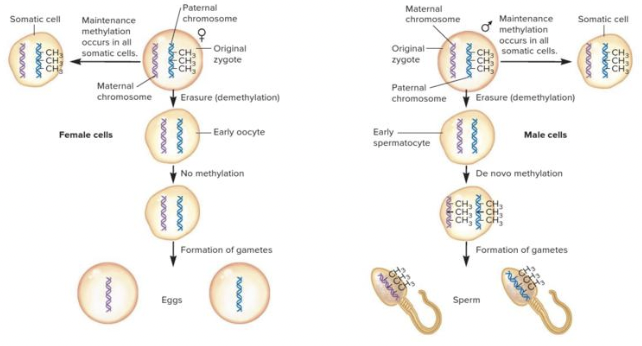
As seen in the figure, de novo methylation of a gene or chromosome occurs in ______.
Multiple choice question.
somatic cells
gametes
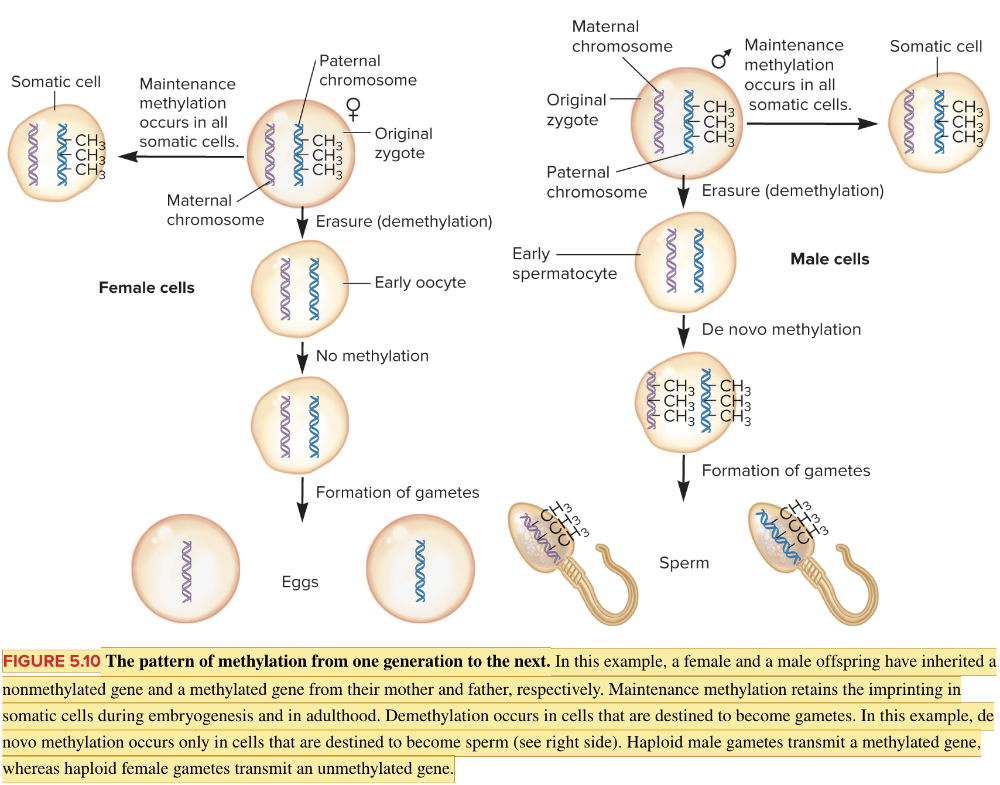
gametes
Prader-Willi syndrome is associated with the imprinting of a gene encoding a splicing factor called ______.
Multiple choice question.
snoRNA
SNRPN
NDN
UBE3A
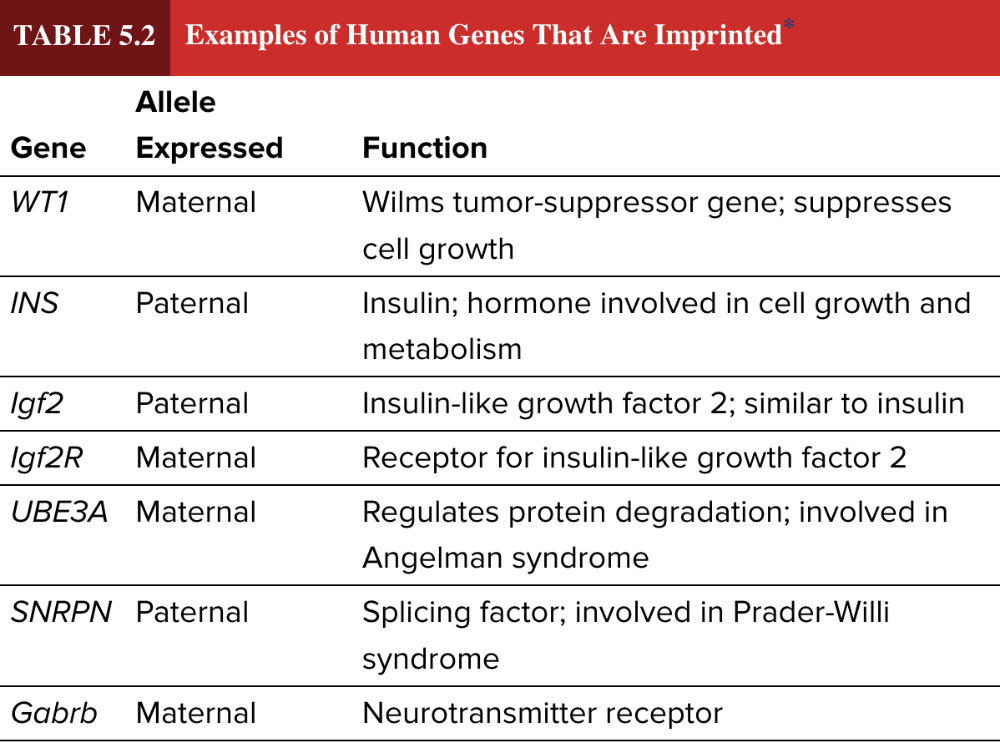
SNRPN
Select all that apply
Which of these are examples of extranuclear genes?
Multiple select question.
Genes located on a chromosome in the nucleus
Genes located on a chromosome in a mitochondrion
Genes located on a chromosome in a chloroplast
Genes located on a chromosome in a mitochondrion
Genes located on a chromosome in a chloroplast
The human diseases Prader-Willi syndrome and Angelman syndrome are influenced by ______.
Multiple choice question.
maternal effect
heteroplasmy
genomic imprinting
paternal leakage
genomic imprinting
Reason:
These diseases depend on inheriting a specific chromosomal deletion either from the father or mother.
Fill in the blank question.
An offspring receives genetic material located in the mitochondria. This is an example of ____ inheritance.
Blank 1: extranuclear, cytoplasmic, maternal, or nonmendelian

Based on the genomic imprints in the figure, the fertilized egg on the left will have which genetic disease?
Multiple choice question.
Angelman syndrome
Prader-Willi syndrome

Angelman syndrome
Reason:
If a chromosome 15 deletion is inherited from the mother, Angelman syndrome occurs because the offspring does not inherit an active copy of the AS gene.
A mitochondrion or chloroplast ______ one nucleoid.
Multiple choice question.
may have more than one
will only have one
may have more than one
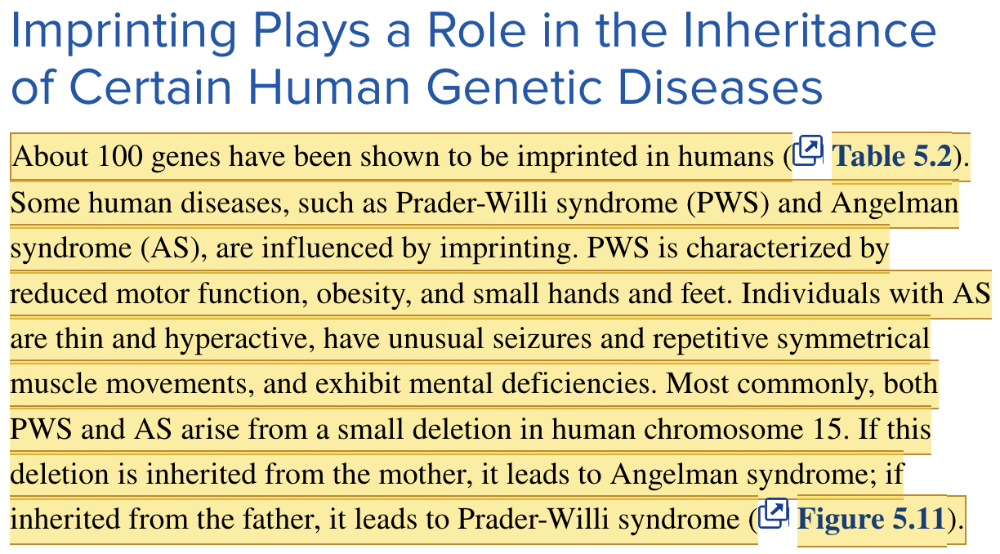
A deletion of a region of chromosome 15 that includes the gene ____ has been shown to cause Angelman syndrome.
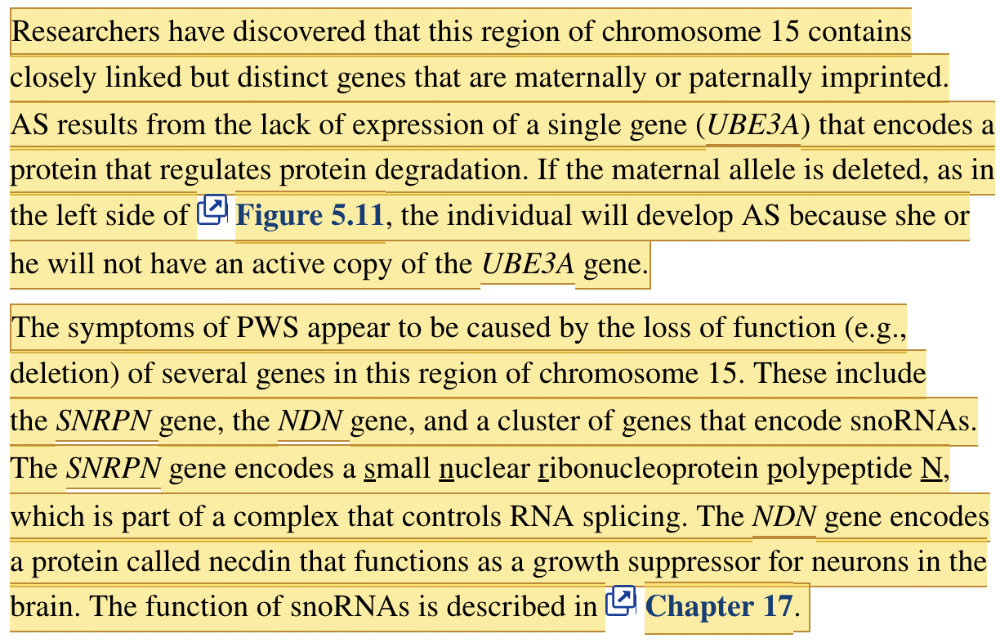
UBE3A
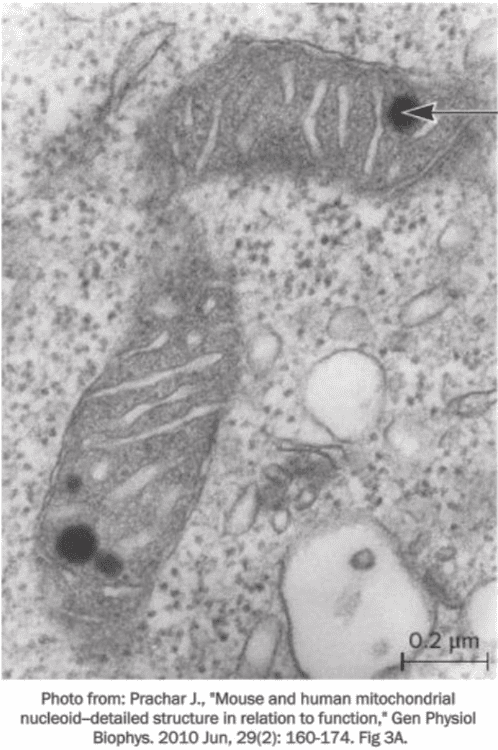
Fill in the blank question.
In a mitochondrion, genetic material is located in a region called the ____, as indicated by the arrow in the image.
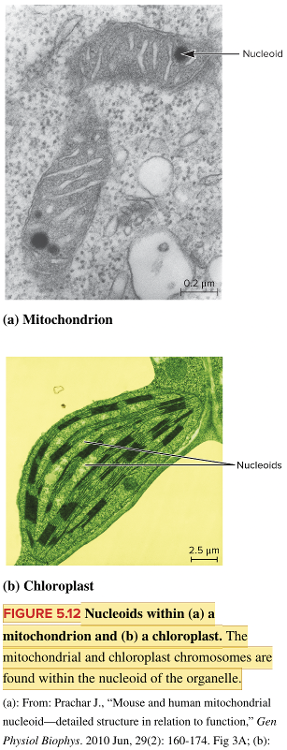
nucleoid
Select all that apply
Which chromosome 15 genes are lost in the deletion causing Prader-Willi syndrome?
Multiple select question.
SNRPN
NDN
UBE3A
snoRNA genes
SNRPN
NDN
snoRNA genes
Genes located on chromosomes are called nuclear genes because they are located in the cell
nucleus
Select all that apply
Select all of these that are true of mitochondrial genes.
Multiple select question.
Most mitochondrial proteins are encoded by nuclear genes.
Human mtDNA carries relatively few genes.
Mitochondrial DNA contains only coding regions.
All mitochondrial proteins are encoded by mitochondrial genes.
Mitochondrial DNA contains both coding and noncoding regions.
Most mitochondrial proteins are encoded by nuclear genes.
Human mtDNA carries relatively few genes.
Mitochondrial DNA contains both coding and noncoding regions.
Select all that apply
The genetic material inherited in an organelle, such as a mitochondrion or a chloroplast, exhibits _____ inheritance.
Multiple select question.
extranuclear
mendelian
cytoplasmic
nuclear
extranuclear
cytoplasmic
True or false: An organelle such as a mitochondrion or a chloroplast will only have one nucleoid.
False
Reason:
Organelles often have more than one nucleoid. Chloroplasts found in Euglena may have 20-34 nucleoids.
The genome of a chloroplast is _____ than the genome of a mitochondrion.
Multiple choice question.
the same size as
larger
smaller
larger
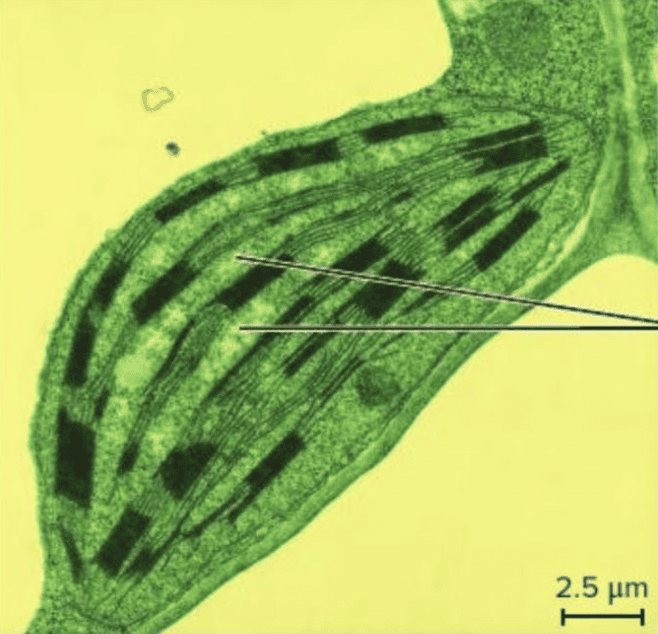
In chloroplasts, DNA is found in regions called ____, as indicated by the lines in the image.

nucleoid
True or false: The genes located in mitochondria and chloroplasts do not exhibit Mendelian patterns of inheritance.
True
Reason:
Extranuclear genes are not segregated into gametes the same way the nuclear chromosomes are. As such, extranuclear genes do not exhibit Mendelian patterns of inheritance.
Prader-Willi syndrome is associated with the imprinting of a gene encoding a splicing factor called ______.
Multiple choice question.
NDN
snoRNA
UBE3A
SNRPN
SNRPN
The type of inheritance that occurs because extranuclear genes are inherited through the cytoplasm of an egg is called
Blank 1: maternal, extranuclear, or cytoplasmicBlank 2: inheritance or inheritence
The size of a human mitochondrial chromosome is ______ the size of a typical bacterial chromosome.
Multiple choice question.
more than 10%
less than 1%
equal to
less than 1%
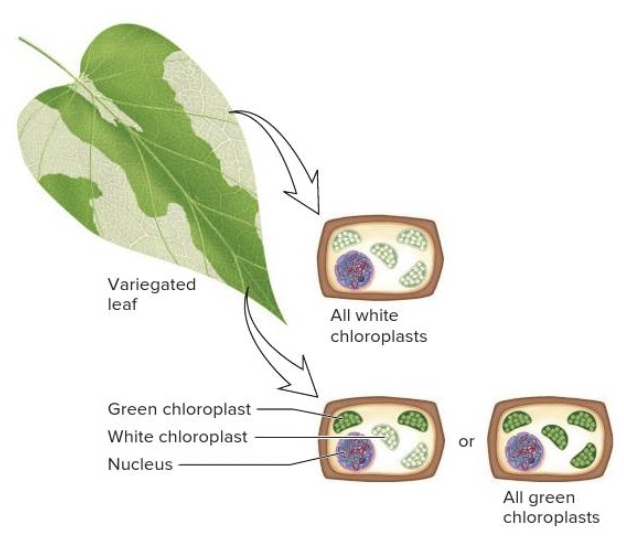
Variegation, a condition in which a leaf will have a mixture of normal and mutant chloroplasts (as shown), is a condition known as
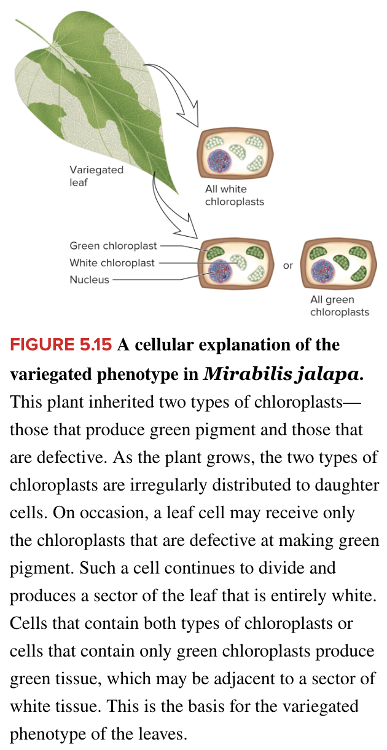
heteroplasmy
Fill in the blank question.
In ____ species, two kinds of gametes are made such that the distribution of cytoplasmic organelles is unequal in the two gamete types and organelles are often inherited from one parent.
heterogamous
Select all that apply
Select all of these that are true of chloroplast DNA.
Multiple select question.
The chloroplast genome is smaller than the mitochondrial genome.
All chloroplast proteins are encoded by chloroplast genes.
A typical chloroplast genome is about 100,000 - 200,000 bp in length.
Many chloroplast proteins are encoded by nuclear genes.
A typical chloroplast genome is about 100,000 - 200,000 bp in length.
Many chloroplast proteins are encoded by nuclear genes.
In a species where maternal inheritance is the norm, the rare case in which mitochondria are provided by the sperm is a phenomenon called
paternal leakage
Extranuclear genes are not segregated into gametes the same way the nuclear chromosomes are. As such, extranuclear genes ______ exhibit Mendelian patterns of inheritance.
Multiple choice question.
do
do not
do not
In chloroplasts, the gene for the photosynthetic enzyme RUBISCO can be mutated. Leaf cells with chloroplasts carrying this mutation will appear white due to the absence of photosynthesis. Leaves with a mixture of mutated and non-mutated chloroplasts show heteroplasmy, with green and white variegation. The RUBISCO gene is inherited from the mother. If the mother plant has green leaves and the father plant has white leaves, which types of leaves can be seen among the offspring?
Multiple choice question.
white, green, and variegated
green
white
white and green but not variegated
variegated
green
Chloroplasts and mitochondria are inherited through the cytoplasm of the egg. This type of extranuclear inheritance is called ______.
Multiple choice question.
genomic imprinting
heteroplasmy
maternal inheritance
maternal effect
maternal inheritance
Select all that apply
Select characteristics of mitochondrial DNA mutations.
Multiple select question.
Mitochondrial DNA mutations may occur in somatic cells and accumulate as a person ages.
Mitochondrial DNA mutations are only inherited from the father.
Mitochondrial DNA mutations are transmitted from a mother only to her male offspring.
Mitochondrial DNA mutations are only found in gamete-forming cells, not in somatic cells.
Mitochondrial DNA mutations are transmitted from a mother to all of her offspring.
Mitochondrial DNA mutations may occur in somatic cells and accumulate as a person ages.
Mitochondrial DNA mutations are transmitted from a mother to all of her offspring.
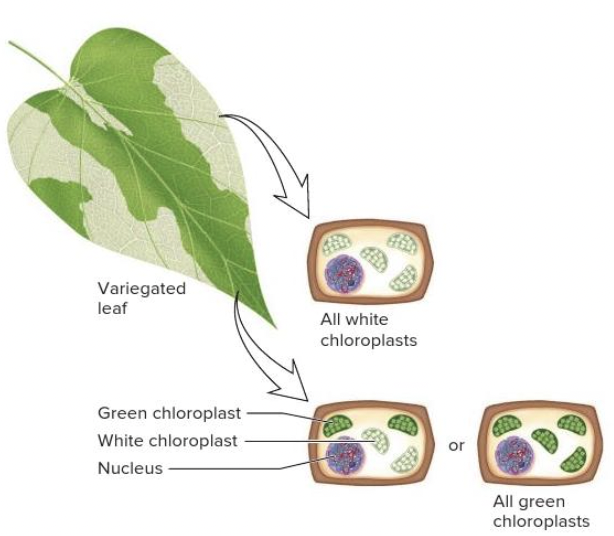
The variegation of the leaf shown in the image can be explained by ______.
Multiple choice question.
X-chromosome inactivation
heteroplasmy
paternal leakage
Mendelian inheritance

heteroplasmy
Human mitochondrial diseases, such as Leber hereditary optic neuropathy, are usually ______ inherited.
Multiple choice question.
maternally
paternally
maternally
A species that produces two kinds of gametes, with unequal distribution of cytoplasmic organelles, is said to be a ______ species.
Multiple choice question.
codominant
incompletely penetrant
heterogamous
incompletely dominant
heterogamous
Select all that apply
Which human diseases are caused by mutations in mitochondrial DNA?
Multiple select question.
Angelman syndrome
Neurogenic muscle weakness
Prader-Willi syndrome
Leber hereditary optic neuropathy
Neurogenic muscle weakness
Leber hereditary optic neuropathy
For a human offspring to express a paternal mitochondrial gene, the individual must have inherited a mitochondrion from the sperm. This is called ______.
Multiple choice question.
paternal leakage
maternal leakage
incomplete penetrance
incomplete dominance
paternal leakage
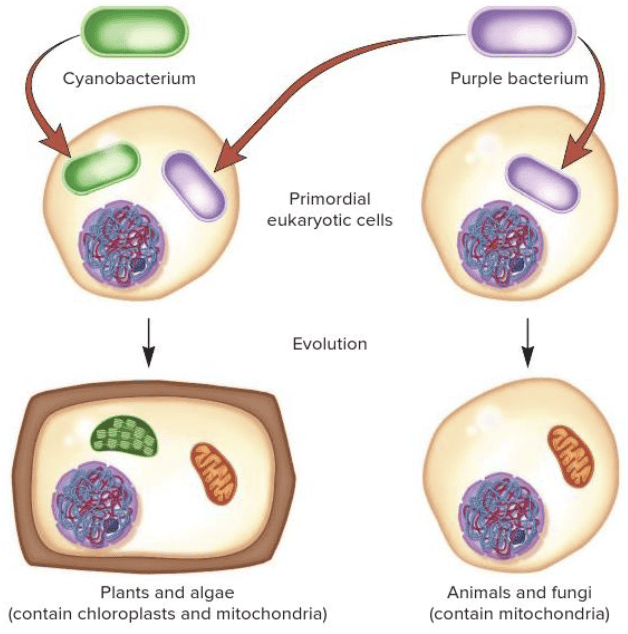
Fill in the blank question.
The theory that explains the evolution of some eukaryotic organelles such as chloroplasts and mitochondria is called the ____ theory.
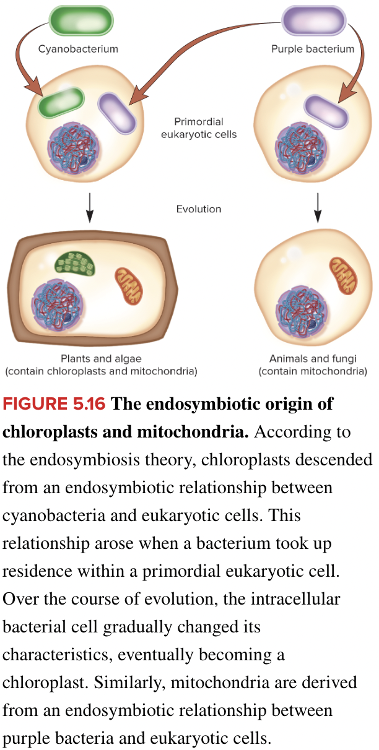
Blank 1: endosymbiosis or endosymbiotic
In chloroplasts, the gene for the photosynthetic enzyme RUBISCO can be mutated. Leaf cells with chloroplasts carrying this mutation will appear white due to the absence of photosynthesis. Leaves with a mixture of mutated and non-mutated chloroplasts show heteroplasmy, with green and white variegation. The RUBISCO gene is inherited from the mother. If the mother plant is variegated and the father plant has fully green leaves, which types of leaves can be seen among the offspring?
Multiple choice question.
variegated only
green and white but not variegated
variegated and green but not white
green, white, and variegated
white only
green only
green, white, and variegated
Which inheritance pattern is typical of the transmission of mutations in mitochondrial DNA in humans?
Multiple choice question.
From the father to his daughters only
From the mother to her sons only
From the mother to her daughters only
From the mother to all of her offspring
From the father to all of his offspring
From the father to his sons only
From the mother to all of her offspring
Mitochondria may have evolved from an endosymbiotic relationship between ______.
Multiple choice question.
purple bacteria and eukaryotic cells
yeast and purple bacteria
algae and eukaryotic cells
cyanobacteria and purple bacteria

purple bacteria and eukaryotic cells
Reason:
Both cyanobacteria and purple bacteria were involved in the endosymbiotic origin of chloroplasts and mitochondria. However, they do not exhibit an endosymbiotic relationship with each other. Mitochondria evolved from an endosymbiotic relationship between purple bacteria and eukaryotic cells. Chloroplasts evolved from an endosymbiotic relationship between cyanobacteria and eukaryotic cells.
Select all that apply
Which of these statements are true for human mitochondrial diseases?
Multiple select question.
They are usually chronic degenerative disorders
They result from genomic imprinting
They usually affect cells that require high levels of ATP
They can usually be overcome by functional genes in the cell nucleus
They often exhibit varying degrees of severity within families
They are usually chronic degenerative disorders
They usually affect cells that require high levels of ATP
They often exhibit varying degrees of severity within families
The variation of gene expression that is not related to the variation of the DNA, is transmissible, and is reversible is described as
epigenetics
Which human mitochondrial disease is caused by a mutation in a gene required for ATP synthesis?
Multiple choice question.
Mitochondrial myopathy
Leber hereditary optic neuropathy
Maternal myopathy and cardiomyopathy
Neurogenic muscle weakness
Neurogenic muscle weakness
Fill in the blank question.
The endosymbiosis theory explains how eukaryotic cells developed the cellular organelles: ____ and ____.
mitochondria; chloroplasts
True or false: Because epigenetics refers to heritable changes in gene expression, all epigenetic changes are examples of transgenerational epigenetic inheritance.
False
Reason: Epigenetic changes may be permanent over an individual's life but are not permanent over multiple generations.
Select all that apply
Which of the following are examples of epigenetics?
Multiple select question.
DNA methylation
Localization of histone variants
DNA translocation
Covalent histone modification
Chromatin remodeling
DNA mutation
DNA methylation
Localization of histone variants
Covalent histone modification
Chromatin remodeling
Reason:
Epigenetics is the variation of gene expression that is not related to the variation of the DNA.
Chloroplasts evolved from an endosymbiotic relationship between ______.
Multiple choice question.
purple bacteria and eukaryotic cells
algae and eukaryotic cells
cyanobacteria and eukaryotic cells
cyanobacteria and purple bacteria
yeast and purple bacteria

cyanobacteria and eukaryotic cells
Reason:
Both cyanobacteria and purple bacteria were involved in the endosymbiotic origin of chloroplasts and mitochondria. However, they do not exhibit an endosymbiotic relationship with each other. Mitochondria evolved from an endosymbiotic relationship between purple bacteria and eukaryotic cells. Chloroplasts evolved from an endosymbiotic relationship between cyanobacteria and eukaryotic cells.
How do transcription factors contribute to epigenetic modification?
Multiple choice question.
Transcription factors recruit chromatin modifying proteins, such as DNA methyltransferase.
Transcription factors allow mutated coding sequences to be transcribed.
Transcription factors permanently bind to the DNA preventing the expression of specific gene sequences.
Transcription factors bind to DNA inducing the removal of specific DNA sequences.
Transcription factors recruit chromatin modifying proteins, such as DNA methyltransferase.
Reason:
Transcription factors temporarily bind to DNA and typically increase the level of transcription.
Select all that apply
Which of the following are true regarding epigenetics?
Multiple select question.
Variations are reversible from one generation to the next
Variations of gene expression result from mutations
Epigenetic changes may be transmitted to offspring
Variations of gene expression are unrelated to variations in the DNA base sequence
Epigenetic changes are transmissible from cell to cell
Variations are reversible from one generation to the next
Epigenetic changes may be transmitted to offspring
Variations of gene expression are unrelated to variations in the DNA base sequence
Epigenetic changes are transmissible from cell to cell
Genes that are expressed but do not encode polypeptides produce ____-____ RNAs.
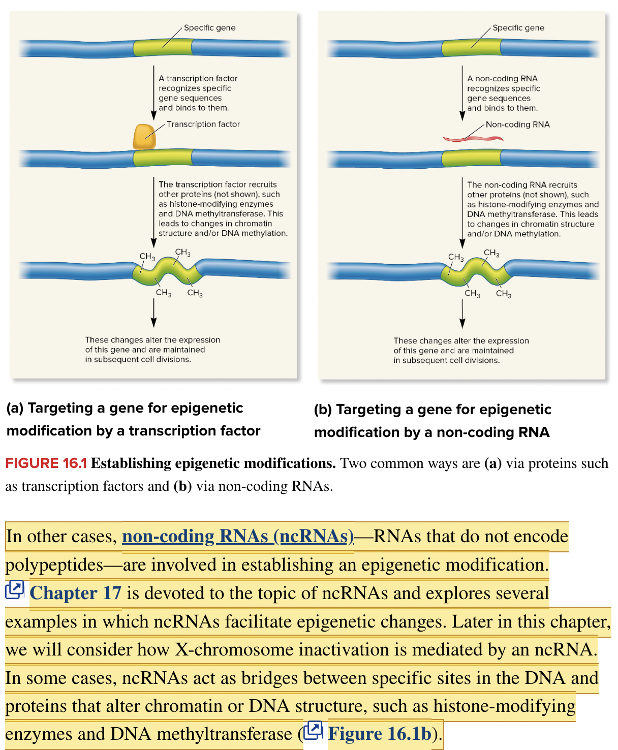
non-coding
Select all that apply
Which human diseases are caused by mutations in mitochondrial DNA?
Multiple select question.
Neurogenic muscle weakness
Prader-Willi syndrome
Leber hereditary optic neuropathy
Angelman syndrome
Neurogenic muscle weakness
Leber hereditary optic neuropathy
If an epigenetic change is maintained only at a given site and does not affect the expression of a gene elsewhere in the nucleus, it is a ______ mechanism.
Multiple choice question.
trans-epigenetic
cis-epigenetic
cis-epigenetic
Reason:
Trans-epigenetic mechanisms occur when a gene is activated that encodes a transcription factor that is capable of stimulating its own expression. The transcription factor may also turn on other genes.
Which of the following is an example of epigenetic inheritance?
Multiple choice question.
A modified histone in a stem cell
A chromatin modification that causes cancer in a lung cell
Methylation of DNA that occurs in an oocyte
Mutation of DNA in a sperm cell
Methylation of DNA that occurs in an oocyte
Reason:
Stem cells are somatic cells that will pass changes to other somatic cells but not to offspring.
Reason:
Changes that cause cancer in somatic cells are not transmitted to offspring.
Reason:
Changes in DNA sequence are genetic, rather than epigenetic, changes.
Select all that apply
Trans-epigenetic mechanisms are more commonly found in ______.
Multiple select question.
plants
single-celled eukaryotes
multicellular eukaryotes
bacteria
animals
single-celled eukaryotes
bacteria
Reason:
Trans-epigenetic mechanisms are more commonly found in prokaryotes (bacteria and archaea) and single celled eukaryotes.
DNA methylation, chromatin remodeling, covalent histone modification, and localization of histone variants are all examples of molecular mechanisms that are involved in
epigenetics
Which of the following statements regarding X chromosome inactivation is true?
Multiple choice question.
X chromosome inactivation occurs during embryogenesis in both females and XY males.
X chromosome inactivation occurs during embryogenesis in females.
X chromosome inactivation occurs during embryogenesis in XY males.
X chromosome inactivation occurs during embryogenesis in females.
True or false: Gene regulation may be related to epigenetic events such as the binding of transcription factors to certain genes, which induce permanent mutations in the DNA.
False
Reason:
Epigenetics due to changes in gene expression that do not involve changes in DNA sequence. Transcription factors recruit proteins that produce changes in gene expression but do not lead to mutations.
Select all that apply
Which statements are examples of how environmental factors may function as epigenetic regulators?
Multiple select question.
Phenotypic changes occur due to a spontaneous frameshift mutation that alters protein folding.
Vernalization occurs when certain flowering plants are exposed to colder temperatures during the previous winter.
Genomic imprinting during development leads to phenotypic changes.
Body differences between queen bees and worker bees are caused by dietary differences.
Exposure to tobacco smoke has been shown to alter DNA methylation and covalent modifications of specific genes in lung cells.
Vernalization occurs when certain flowering plants are exposed to colder temperatures during the previous winter.
Body differences between queen bees and worker bees are caused by dietary differences.
Exposure to tobacco smoke has been shown to alter DNA methylation and covalent modifications of specific genes in lung cells.
An RNA that does not encode a polypeptide is a(n) ______ RNA.
Multiple choice question.
immature
secondary
non-coding
structural
non-coding
Select all that apply
Which of the following are characteristics of euchromatin?
Multiple select question.
Localized along the periphery of the cell nucleus
Inhibition of gene expression
Highly compact structure
High level of gene expression
Occupies a central position in the nucleus
High level of gene expression
Occupies a central position in the nucleus
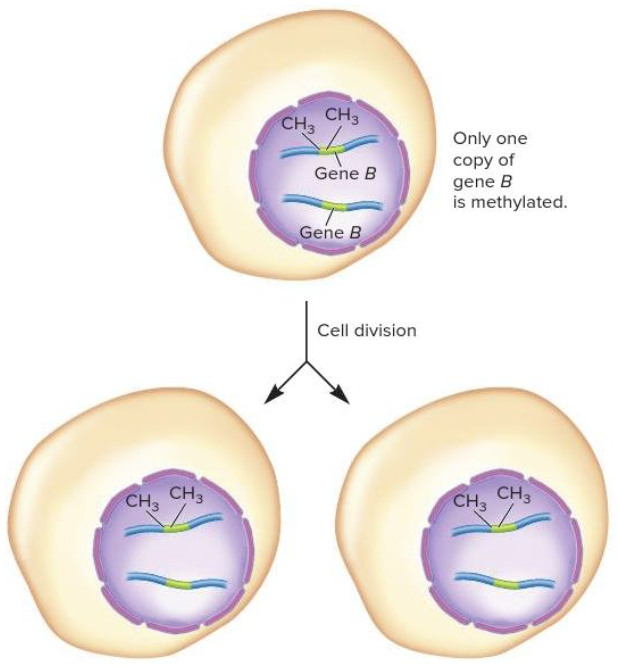
Which type of epigenetic mechanism is shown in the image?
Multiple choice question.
cis-epigenetic mechanism
trans-epigenetic mechanism
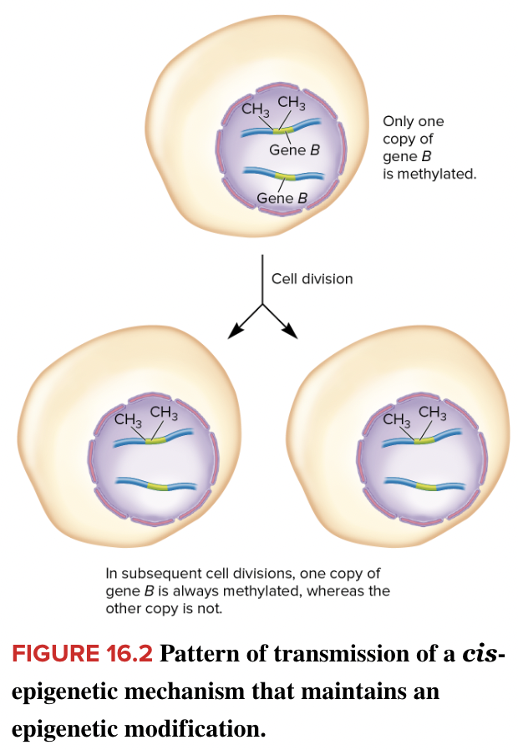
cis-epigenetic mechanism
Reason:
If an epigenetic change is maintained only at a given site and does not affect the expression of a gene elsewhere in the nucleus it is a cis-epigenetic mechanism.
Reason:
Trans-epigenetic mechanisms occur when a gene is activated that encodes a transcription factor that is capable of stimulating its own expression. The transcription factor may also turn on other genes.
Select all that apply
The role of heterochromatin in repressing transcription may be due to interference with which of the following factors?
Multiple select question.
General transcription factors
Transcriptional activators
Coactivators
RNA polymerase II
General transcription factors
Transcriptional activators
Coactivators
Activation of a gene that encodes a transcription factor capable of stimulating its own expression and/or the expression of other genes is an example of a ______ mechanism.
Multiple choice question.
cis-epigenetic
trans-epigenetic
trans-epigenetic
Reason:
A cis-epigenetic change is maintained only at a given site and does not affect the expression of a gene elsewhere in the nucleus.
Genomic imprinting and X-chromosome inactivation are examples of ______ mechanisms that occur during development.
Multiple choice question.
trans-epigenetic
cis-epigenetic
cis-epigenetic
Reason:
Trans-epigenetic mechanisms occur when a gene is activated that encodes a transcription factor that is capable of stimulating its own expression. The transcription factor may also turn on other genes.
How does heterochromatin prevent the movement of transposable elements (TEs)?
Multiple choice question.
Promoting histone acetylation in chromatin containing TEs
Silencing genes needed for transposition
Removing nucleosomes from regions containing TEs
Preventing DNA replication of TEs
Silencing genes needed for transposition
Select all that apply
Which of the following are environmental factors that promote epigenetic changes?
Multiple select question.
Temperature
Genomic imprinting
X chromosome inactivation
Diet
Toxins
Temperature
Diet
Toxins
Reason:
This is an example of an epigenetic change rather than an environmental factor promoting the change.
Characteristics of heterochromatin include which of the following?
Multiple select question.
Inhibition of gene expression
Localized along the periphery of the cell nucleus
Highly compact structure
Occupies a central position in the nucleus
High level of gene expression
Inhibition of gene expression
Localized along the periphery of the cell nucleus
Highly compact structure
Select all that apply
Identify ways that heterochromatin can inhibit transcription.
Multiple select question.
Preventing activators from binding to enhancer sequences
Inhibiting the recruitment of general transcription factors or coactivators
Creating nucleosome-free regions near promoters
Increasing the level of DNA methylation in promoter regions
Preventing activators from binding to enhancer sequences
Inhibiting the recruitment of general transcription factors or coactivators
How does heterochromatin prevent the proliferation of viruses?
Multiple choice question.
Preventing the replication of DNA regions containing proviral DNA
Enhancing the integration of the virus into the DNA of the host cell
Inhibiting the expression of viral genes needed to produce new viruses
Preventing the packaging of viral DNA into the viral protein coat
Inhibiting the expression of viral genes needed to produce new viruses
Select all that apply
Trans-epigenetic mechanisms are more commonly found in ______.
Multiple select question.
bacteria
single-celled eukaryotes
plants
multicellular eukaryotes
animals
bacteria (prokaryotes)
single-celled eukaryotes
Reason:
Trans-epigenetic mechanisms are more commonly found in prokaryotes (bacteria and archaea) and single celled eukaryotes.
Fill in the blank question.
Regions of heterochromatin that vary among different cell types are called heterochromatin.
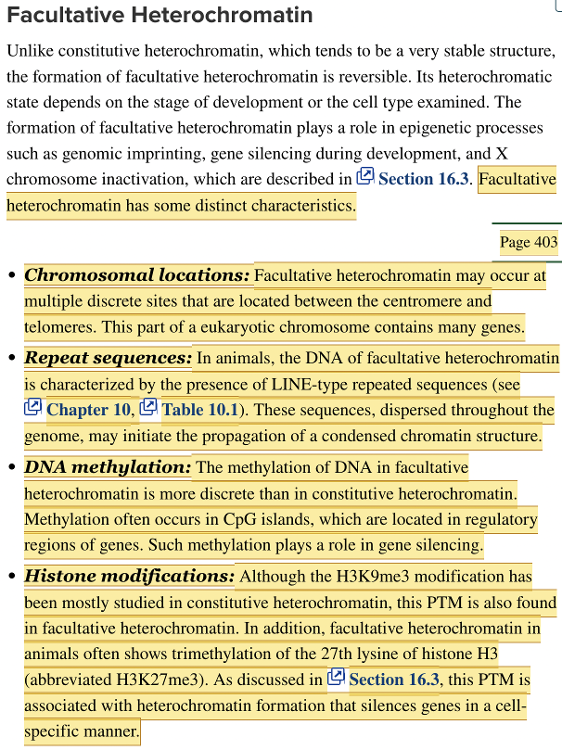
facultative
When sites containing transposable elements (TEs) are converted to heterochromatin, the TEs are prevented from moving because the genes for transposition are ______.
Multiple choice question.
silenced
over expressed
mutated
activated
silenced
Regions of the chromatin containing numerous, short, tandemly repeated sequences that are located near the centromeres and at the telomeres of eukaryotic chromosomes are called ______ heterochromatin.
Multiple choice question.
euchromatic
facultative
constitutive
activated
constitutive
Fill in the blank question.
Regions of a protein that catalyze the addition of posttranslational modifications (PTMs) are called ____ domains.
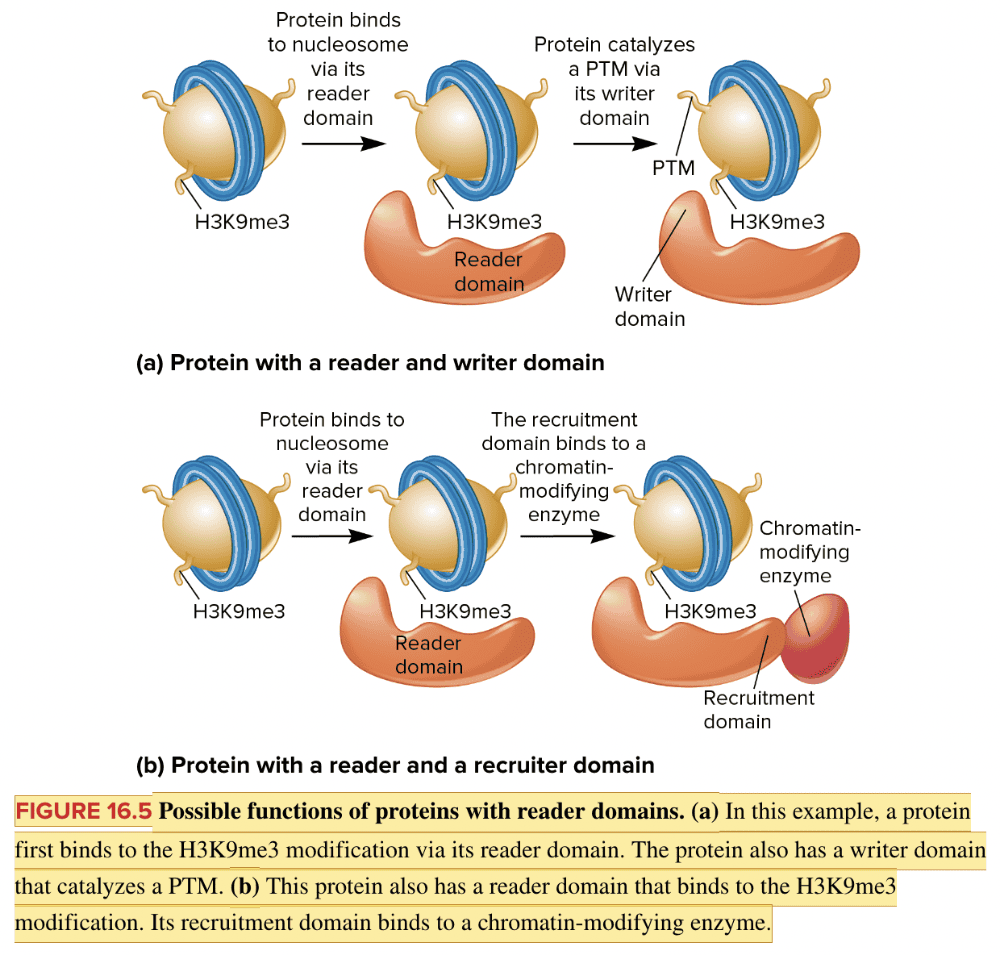
writer
In the prevention of viral proliferation, what affect does heterochromatin have on a virus that has integrated into the host genome as proviral DNA?
Multiple choice question.
Prevents nucleosome formation near the promoters of proviral genes
Prevents expression of proviral genes needed to produce new viruses
Causes the excision of proviral DNA from the host genome
Causes mutations in proviral DNA that result in the formation of faulty products
Prevents expression of proviral genes needed to produce new viruses
Hypoacetylation of lysines in histone tails is a common modification found in ______.
Multiple choice question.
transcriptionally active regions
facultative euchromatin
constitutive heterochromatin
constitutive euchromatin
constitutive heterochromatin
Fill in the blank question.
Regions of heterochromatin that are seen in the same location in all cell types are called ____ heterochromatin.
constitutive
When bound to a nucleosome carrying a modified histone, a binding protein with a reader domain but no writer domain will ______.
Multiple choice question.
recruit chromatin-modifying enzymes
reposition the surrounding nucleosomes
catalyze a posttranslational modification
methylate the associated DNA
recruit chromatin-modifying enzymes
Heterochromatic regions found at multiple discrete sites located between the centromeres and telomeres, and which contain methylated DNA at CpG islands in regulatory regions, are called ______ heterochromatin.
Multiple choice question.
facultative
euchromatic
constitutive
activated
facultative
Select all that apply
Which of the following are features associated with constitutive heterochromatin in yeast and animal cells?
Multiple select question.
Composed of many, short tandemly repeated sequences
Located at telomeres and close to centromeres
Significant number of nucleosome-free regions near gene promoters
Trimethylation of a lysine at the ninth position in histone H3
DNA is highly methylated on cytosines
DNA is composed of unique gene sequences
Composed of many, short tandemly repeated sequences
Located at telomeres and close to centromeres
Trimethylation of a lysine at the ninth position in histone H3
DNA is highly methylated on cytosines
Match the type of chromatin structure with the stage of the cell cycle in which it would be observed.
Interphase
M phase
M phase through interphase in two daughter cells
Euchromatic regions condense into constitutive and facultative heterochromatin.
Constitutive and facultative heterochromatin regions retain the same pattern observed in mother cell.
Most chromosomal regions are composed of euchromatin.
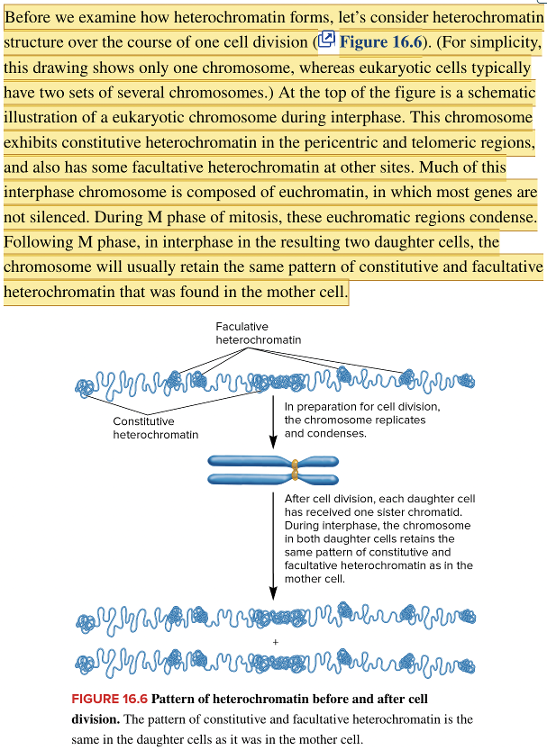
- Interphase Most chromosomal regions are composed of euchromatin.
- M phase Euchromatic regions condense into constitutive and facultative heterochromatin.
- M phase through interphase in two daughter cells Constitutive and facultative heterochromatin regions retain the same pattern observed in mother cell.
Regions of a protein that control the binding of particular proteins to nucleosomes with posttranslational modifications (PTMs) are called ______ domains.
Multiple choice question.
reader
eraser
sensor
writer
reader
Fill in the blank question.
Any assemblage of nucleosomes that assumes a reproducible confirmation in three-dimensional space represents a(n) ____-____ structure.
higher-order
Which modification is commonly found for lysines in histones associated with constitutive heterochromatin?
Multiple choice question.
hypomethylation
hyperacetylation
hypoacetylation
hypoacetylation
Once bound to a nucleosome carrying a modified histone, a binding protein with both a reader and writer domain will ______.
Multiple choice question.
catalyze a posttranslational modification
methylate the associated DNA
recruit chromatin-modifying enzymes
reposition the surrounding nucleosomes
catalyze a posttranslational modification
Select all that apply
Which of the following are features associated with facultative heterochromatin?
Multiple select question.
Trimethylation of histone H3 at the 9th or 27th lysine
Located at telomeres and close to centromeres
Methylation at CpG islands located in the regulatory regions of genes
Composed of many, short tandemly repeated sequences
In animals, contain LINE-type repeated sequences
Located at multiple discrete sites between the centromere and telomeres
Trimethylation of histone H3 at the 9th or 27th lysine
Methylation at CpG islands located in the regulatory regions of genes
In animals, contain LINE-type repeated sequences
Located at multiple discrete sites between the centromere and telomeres
Select all that apply
Which molecular processes will enhance the formation of higher-order structure in heterochromatin?
Multiple select question.
Formation of nucleosome-free regions
Unwinding of DNA from histone octamers
Posttranslational modifications of histones
Binding of proteins to nucleosomes
DNA methylation
Posttranslational modifications of histones
Binding of proteins to nucleosomes
DNA methylation
Fill in the blank question.
During cell division, from M phase in the mother cell to interphase in the resulting two daughter cells, a chromosome will usually retain the same pattern of ____ and ____ heterochromatin that was found in the mother cell.
Blank 1: constitutive
Blank 2: facultative
Select all that apply
Higher-order heterochromatin structure is characterized by ______.
Multiple select question.
closer contacts between nucleosomes
formation of loop domains
establishing nucleosome-free regions
hypomethylation of DNA and histones
binding of heterochromatin to the nuclear lamina
formation of loop domains
closer contacts between nucleosomes
binding of heterochromatin to the nuclear lamina
Which of the following represents a higher-order structure found in chromatin?
Multiple choice question.
30-nm fiber
Histone octamer
Extended chain of nucleosomes
Nucleosome
DNA double helix
30-nm fiber
When binding to chromatin, where would a dimer of heterochromatin protein 1 (HP1) be found?
Multiple choice question.
In the linker region between nucleosomes
Attached to the DNA that is coiled around the histone octamer
Spanning a coiled region containing four nucleosomes
In the linker region between nucleosomes
Hypoacetylation of lysines in histone tails is a common modification found in ______.
Multiple choice question.
facultative euchromatin
transcriptionally active regions
constitutive euchromatin
constitutive heterochromatin
constitutive heterochromatin
When bound to a nucleosome carrying a modified histone, a binding protein with a reader domain but no writer domain will ______.
Multiple choice question.
reposition the surrounding nucleosomes
recruit chromatin-modifying enzymes
catalyze a posttranslational modification
methylate the associated DNA
recruit chromatin-modifying enzymes
Fill in the blank question.
Formation of higher-order structures in heterochromatin depends upon posttranslational modifications of ____, binding of proteins to ____, and the process of DNA ____.
Blank 1: histones
Blank 2: nucleosomes
Blank 3: methylation
Fill in the blank question.
Heterochromatin protein 1 (HP1) causes changes in heterochromatin structure when HP1 dimers ____ chromatin-modifying enzymes and chromatin-remodeling complexes to the site of dimer binding.
recruit or attract
Fill in the blank question.
Characteristics of higher-order heterochromatin structure include closer contact between ____, formation of ____ domains and binding of heterochromatin to the nuclear ____.
Blank 1: nucleosomes
Blank 2: loop
Blank 3: lamina
Condensin and CCCTC-binding factor (CTCF) are involved in forming ____ domains in heterochromatin.
loop
A protein that forms a dimer in the linker region between nucleosomes carrying the modified histone H3K9me3 is ______.
Multiple choice question.
euchromatin protein 1 (EU1)
heterochromatin protein 1 (HP1)
histone H1
CCCTC-binding factor (CTCF)
heterochromatin protein 1 (HP1)
A fibrous layer of proteins lining the inner nuclear membrane of eukaryotic cells is called the ______.
Multiple choice question.
nuclear envelope
nuclear lamina
nucleolus
nuclear matrix
nuclear lamina
Select all that apply
Once heterochromatin protein 1 (HP1) forms a dimer in the linker region between nucleosomes, which types of proteins does it recruit to the site?
Multiple select question.
Chromatin-remodeling complexes
RNA polymerases
Histones with posttranslational modifications
Chromatin-modifying enzymes
Chromatin-remodeling complexes
Chromatin-modifying enzymes
Chromosomal regions that are in close contact with the nuclear lamina are called lamina-associated
domains
Select all that apply
Identify proteins involved in forming loop domains in heterochromatin.
Multiple select question.
CCCTC-binding protein
condensin
heterochromatin protein 1 (HP1)
histone H1
H3K9me3
CCCTC-binding protein
condensin
Select all that apply
Select the roles that lamina-associated domains (LADs) are thought to fulfill.
Multiple select question.
Organize interphase chromosomes into chromosome territories
Inhibit gene expression
Enhance gene expression
Promote higher levels of chromatin condensation
Organize interphase chromosomes into chromosome territories
Inhibit gene expression
In most eukaryotic cells, the inner nuclear membrane of the cell is lined by a fibrous layer of proteins called the nuclear
lamina
Select all that apply
Which characteristics are observed for lamina-associated domains (LADs)?
Multiple select question.
Found in both constitutive and facultative heterochromatin
Contain a large number of nucleosome-free regions
Contain about 2500 nucleosomes
Show high levels of histone modification
Found only in constitutive heterochromatin
Found in both constitutive and facultative heterochromatin
Contain about 2500 nucleosomes
Show high levels of histone modification
Hypoacetylation of lysines in histone tails is a common modification found in ______.
Multiple choice question.
constitutive heterochromatin
constitutive euchromatin
transcriptionally active regions
facultative euchromatin
constitutive heterochromatin
Which components can initiate heterochromatin formation at a nucleation site?
Multiple select question.
sequence-specific DNA binding proteins
chromatin-modifying proteins
non-coding RNA
H3K9me3
Reason:
Trimethylation of H3 results from the nucleation process.
CCCTC-binding factors (CTCFs)
sequence-specific DNA binding proteins
non-coding RNA
Reason:
Trimethylation of H3 results from the nucleation process.
Lamina-associated domains (LADs) are regions of ______ found in close contact with the nuclear lamina in eukaryotic cells.
Multiple choice question.
chromatin-modifying enzymes
chromosomes
replicating enzymes
chromatin-remodeling complexes
chromosomes
The enzyme that is recruited by heterochromatin protein 1 (HP1) during the spreading phase of heterochromatin formation is histone ______.
Multiple choice question.
acetyltransferase
kinase
methyltransferase
deacetylase
methyltransferase
Fill in the blank question.
Organizing chromosomes into chromosome territories and inhibiting gene expression are two roles of the ____-____ domains found on eukaryotic chromosomes.
Blank 1: lamina
Blank 2: associated
Fill in the blank question.
A typical eukaryotic chromosome contains a few dozen lamina-associated domains (LADs) found in both ____ and ____ heterochromatin.
Blank 1: constitutive
Blank 2: facultative
Select all that apply
Which of the following can act as barriers to prevent spreading of heterochromatin into adjacent euchromatin regions?
Multiple select question.
a region that is fully covered by nucleosomes
a nucleosome-free region
an enhancer sequence
a region containing many antisilencing proteins
a nucleosome-free region
a region containing many antisilencing proteins
Select all that apply
In heterochromatin formation, which of the following are responsible for recruiting histone deacetylases and histone methyltransferases to a nucleation site?
Multiple select question.
CCCTC-binding factors (CTCFs)
Non-coding RNAs
H3K9me3
heterochromatin protein 1 (HP1)
Sequence-specific DNA-binding proteins
Non-coding RNAs
Sequence-specific DNA-binding proteins
During development, the silencing of genes that should not be expressed in a specific cell type occurs by the formation of cell-specific ______ heterochromatin regions.
Multiple choice question.
constitutive
facultative
nucleated
facultative
Select all that apply
During the formation of heterochromatin, which proteins are involved in the self-propagating mechanism responsible for the spreading phase?
Multiple select question.
heterochromatin protein 1 (HP1)
CCCTC-binding factor (CTCF)
histone methyltransferase
histone acetyltransferase
heterochromatin protein 1 (HP1)
histone methyltransferase
A heterochromatic region with fully methylated DNA and extensively modified histone H3 prior to DNA replication, will have ______ (the) levels of these modifications in the daughter chromatids produced after DNA replication.
Multiple choice question.
the same
1/2
1/4
1/2
Fill in the blank question.
One type of barrier to the spreading of heterochromatin is a region with histone-modifying enzymes that catalyze ____ or ____ of histones to promote the formation of euchromatin and inhibit the formation of heterochromatin.
Blank 1: demethylation
Blank 2: acetylation
Fill in the blank question.
Heterochromatic regions that are cell-specific and silence genes that should not be expressed in a certain cell type are called ____ heterochromatin.
facultative
Fill in the blank question.
DNA methylation and histone trimethylation are mechanisms that quickly reestablish ____ structure after DNA replication.
heterochromatin
Select all that apply
Before replication, a heterochromatic region has sites with fully methylated DNA and nucleosomes with H3K9me3 histone modifications. After DNA replication, what would be the constituents of each daughter chromatid?
Multiple select question.
fully methylated DNA
hemimetylated DNA
half of the H3 histones with H3K9me3 modifications
all of the H3 histones with H3K9me3 modifications
hemimetylated DNA
half of the H3 histones with H3K9me3 modifications
ICF syndrome and Roberts syndrome are inherited diseases associated with abnormalities in ______.
Multiple choice question.
heterochromatin formation
formation of lamina-associated domains (LADs)
nucleosome formation
euchromatin activation
heterochromatin formation
Select all that apply
Abnormalities in heterochromatin formation have resulted from loss-of function mutations affecting the activity of which enzymes?
Multiple select question.
histone deacetylase
acetyltransferase
DNA methyltransferase
histone methyltransferase
acetyltransferase
DNA methyltransferase
Select all that apply
The Igf2 gene will be expressed if ______.
Multiple select question.
the ICR and DMR are methylated
CTC factors bind to the ICR and DMR
the Igf2 gene can be stimulated by the enhancer
the H19 gene is methylated
the ICR and DMR are methylated
the Igf2 gene can be stimulated by the enhancer
Select all that apply
Select mechanisms responsible for reestablishing heterochromatin structure after DNA replication.
Multiple select question.
Presence of higher-order heterochromatin structure
Trimethylation of histones
DNA methylation
Deacetylation of histones
Formation of nucleosome-free regions
Presence of higher-order heterochromatin structure
Trimethylation of histones
DNA methylation
Select all that apply
Idenfity the diseases that have been associated with abnormalities in heterochromatin formation.
Multiple select question.
ICF syndrome
Cancer
Roberts syndrome
Cri-du-chat syndrome
ICF syndrome
Roberts syndrome
The methylation of a previously unmethylated site is called ______.
Multiple choice question.
de novo methylation
de novo mutation
maintenance methylation
induced mutation
de novo methylation
Reason:
The methylation of hemimethylated sites is called maintenance methylation.
Select all that apply
Which two areas of the X chromosome play a key role in X inactivation?
Multiple select question.
Tsix
Xist
Igf2
H19
Tsix
Xist
Fill in the blank question.
Two inherited human diseases related to abnormalities in heterochromatin formation are ICF syndrome due to a loss-of-function mutation in a DNA ____ enzyme related to constitutive heterochromatin formation, and Roberts syndrome due to a loss-of-function mutation in a(n) ____ enzyme involved in establishing sister-chromatid cohesion.
Blank 1: methyltransferase
Blank 2: acetyltransferase
What accounts for the molecular mechanism of imprinting of the Igf2 gene?
Multiple choice question.
Spontaneous mutation in the Igf2 gene
Differential methylation during oogenesis and spermatogenesis
Spontaneous mutation in the H19 gene
Differential methylation during fetal development
Differential methylation during oogenesis and spermatogenesis
Reason:
The molecular mechanism of Igf2 imprinting is due to different patterns of methylation during spermatogenesis and oogenesis.
What happens when pluripotency factors stimulate the expression of Tsix?
Multiple choice question.
CTCFs are expressed.
H19 is inhibited.
Igf2 is expressed.
Xist is inhibited.
Xist is inhibited.
The methylation of hemimethylated sites is called ______.
Multiple choice question.
an induced mutation
a de novo mutation
maintenance methylation
de novo methylation
maintenance methylation
Reason:
The methylation of a previously unmethylated site is called de novo methylation.
Select all that apply
Which of the following statements regarding X inactivation are true?
Multiple select question.
Expression of Tsix from both X chromosomes inhibits the expression of Xist
In very early embryos, both X chromosomes are active
Pluripotency factors inhibit the expression of Tsix
When the Xist gene is inactive the X chromosome is active
Expression of Tsix from both X chromosomes inhibits the expression of Xist
In very early embryos, both X chromosomes are active
When the Xist gene is inactive the X chromosome is active
X-chromosome inactivation is an epigenetic event that occurs during ______.
Multiple choice question.
spermatogenesis
the postnatal period
embryogenesis
oogenesis
embryogenesis
Click and drag on elements in order
List the events of X-chromosome inactivation in the correct sequence. putting the first event at the top.
All pluripotency factors and CTCFs are shifted to one of the two X chromosomes
The Tsix gene of the chromosome without pluripotency factors and CTCFs is inhibited; the inactivated chromosome is coated with Xist RNA
X chromosomes pair briefly beginning at the Tsix gene
Xist RNA recruits proteins that epigenetically modify specific sites within the Xi
1. X chromosomes pair briedly beginning at the Tsix
gene
2. All pulipotency factors and CTCFs are shifted to one of
the two x chromosomes
3. The Tsix gene of the chromosome
without pluripotency factors and CTCFs is inhibited; the inactivated
chromosome is coated with Xist RNA
4. Xist rna
recruits proteins that epigeneticallt modify specific sites within the Xi
True or false: The epigenetic modifications that lead to silencing of an X chromosome are lost and reestablished following each cell division.
False
Reason:
The epigenetic modifications in Xi are maintained in subsequent cell divisions.
Select all that apply
Identify changes that can occur during embryonic development that will lead to a pattern of differential gene expression unique to a specific cell type.
Multiple select question.
Loss of DNA containing genes not required for a specific cell type
Genetic mutations that disable genes whose products are not needed in a specific cell type
Epigenetic changes that enable specific genes to be transcribed
Epigenetic changes that cause specific genes to be permanently repressed
Epigenetic changes that enable specific genes to be transcribed
Epigenetic changes that cause specific genes to be permanently repressed
Select all that apply
Which two complexes are the key regulators of epigenetic changes that occur during development?
Multiple select question.
Trithorax group
Imprinting control region
Polycomb group
X-inactivation center
Trithorax group
Polycomb group
The inactivation of an X chromosome is a(n) ______ event.
Multiple choice question.
mutational
environmentally-controlled
epigenetic
temperature-dependent
epigenetic
Fill in the blank question.
The PcG complex attaches three methyl groups to lysine at position 27 in histone H3 in a process known as ____. This mark represses gene expression.
trimethylation
The first step of X inactivation occurs when X chromosomes pair briefly beginning at the ______.
Multiple choice question.
Tsix gene
macroH2A
Xist gene
CTCFs
Xi
Tsix gene
Reason:
Pairing occurs at the Tsix gene and pluripotency factors and CTCFs that were previously bound to both chromosomes shift entirely to one chromosome.The chromosome to which they shift becomes active. The other X chromosome does not express Tsix, which permits expression of Xist.
Select all that apply
What are the three ways that PRC1 may inhibit transcription?
Multiple select question.
Covalent modification of H2A by attraction of ubiquitin molecules
Direct interaction with transcription factors
Nucleosomes in the target gene may form knot-like structures
Direct methylation of the nucleotides in the target gene
Covalent modification of H2A by attraction of ubiquitin molecules
Direct interaction with transcription factors
Nucleosomes in the target gene may form knot-like structures
Select all that apply
Which changes occur following the binding of Xist RNAs to the Xi?
Multiple select question.
Recruitment of DNA methyltransferases to Xi
Histone variant macroH2A is incorporated into the nucleosomes along the Xi
Recruitment of protein complexes to Xi
Activation of Tsix and subsequent inhibition of Xist
Covalent modification of specific sites in histone tails
Recruitment of DNA methyltransferases to Xi
Histone variant macroH2A is incorporated into the nucleosomes along the Xi
Recruitment of protein complexes to Xi
Covalent modification of specific sites in histone tails
Fill in the blank question.
During embryonic development, many genes within a specific cell type will undergo epigenetic changes that enable them to be ____ or cause them to be permanently ____.
Blank 1: transcribed or expressed
Blank 2: repressed or silenced
Epigenetic changes due to the actions of PcG complexes ______.
Multiple choice question.
are maintained in subsequent cell divisions
are transient and short lived
have no effect on gene expression
are maintained in subsequent cell divisions
Trithorax group (TrxG) complexes epigenetically influence development by ______ various genes.
Multiple choice question.
inhibiting
activating
activating
Reason:
PcG complexes cause gene repression.
The TrxG complex attaches three methyl groups to lysine at position 4 in histone H3 in a process known as trimethylation. This mark ______ gene expression.
Multiple choice question.
activates
inhibits
activates
The red1 gene in maize produces dark red corn kernels. The red1' allele is paramutagenic and results in light pink kernels. A plant with a red1 allele that has undergone paramutation would have ______ kernels.
Multiple choice question.
dark red
light pink
light pink
Click and drag on elements in order
List the steps of how a gene may be targeted for silencing by PcG complexes in the correct sequence, putting the first step on top.
Transcription is inhibited by preventing binding of RNA polymerase and PRC1 may be recruited to inhibit transcription in various ways
PRE-binding protein binds to PRE and recruits PRC2
PRC2 catalyzes trimethylation of lysine 27 in histone H3
1. Prebinding proteins to pre and recruits prc2
2. Prc2
catalyzes trimethylation of lysine 27 in histone h3
3.
Transcription is inhibited by preventing binding of RNA polymerase and
PRC1 may be recruited to inhibit transcription in various ways
In maize, the red1 + allele can change the expression level of red1 allele. The red1 allele is the ______ allele.
Multiple choice question.
paramutable
paramutagenic
paramutable
Reason:
The paramutagenic allele is the allele that can change the expression of another allele. In this case the paramutagenic allele is the red1+ allele.
In maize, the dominant allele B-I encodes a transcription factor that regulates genes involved in producing purple color of corn stalks and husks. The allele can undergo a mutation to B' which changes the stalk and husk color from purple to green. In a cross between B-I B-I and B' B' homozygotes, the F1 heterozygotes all have green stalks and husks. This shows that the B' allele is ____ and the B-I allele is ____.
Blank 1: paramutagenic
Blank 2: paramutable
True or false: Epigenetic changes due to PcG complexes are transient and only present during development.
False
Reason:
Epigenetic changes due to the actions of PcG complexes are maintained in subsequent cell divisions.
Select all that apply
Which of the following factors determine the effects of paramutation?
Multiple select question.
The number of paramutagenic alleles in the genome
The rate of paramutation of the paramutagenic allele
The stability of the paramutagenic allele
The effectiveness of DNA repair systems
The rate of paramutation of the paramutagenic allele
The stability of the paramutagenic allele
Polycomb group (PcG) complexes epigenetically influence development by ______ various genes.
Multiple choice question.
activating
inhibiting
inhibiting
The mop1 gene, which is required for paramutation in Arabidopsis, encodes ______ that produces siRNA for gene silencing.
Multiple choice question.
a DNA-dependent RNA polymerase
an exonuclease
an RNA-dependent RNA polymerase
a DNA methyltransferase
an RNA-dependent RNA polymerase
The bI gene in maize regulates pigment synthesis. The B-I allele is dominant and produces purple husks, but the B' allele is paramutagenic and results in green husks. A B-I B' heterozygous plant would be expected to have ______ husks.
Multiple choice question.
green
purple
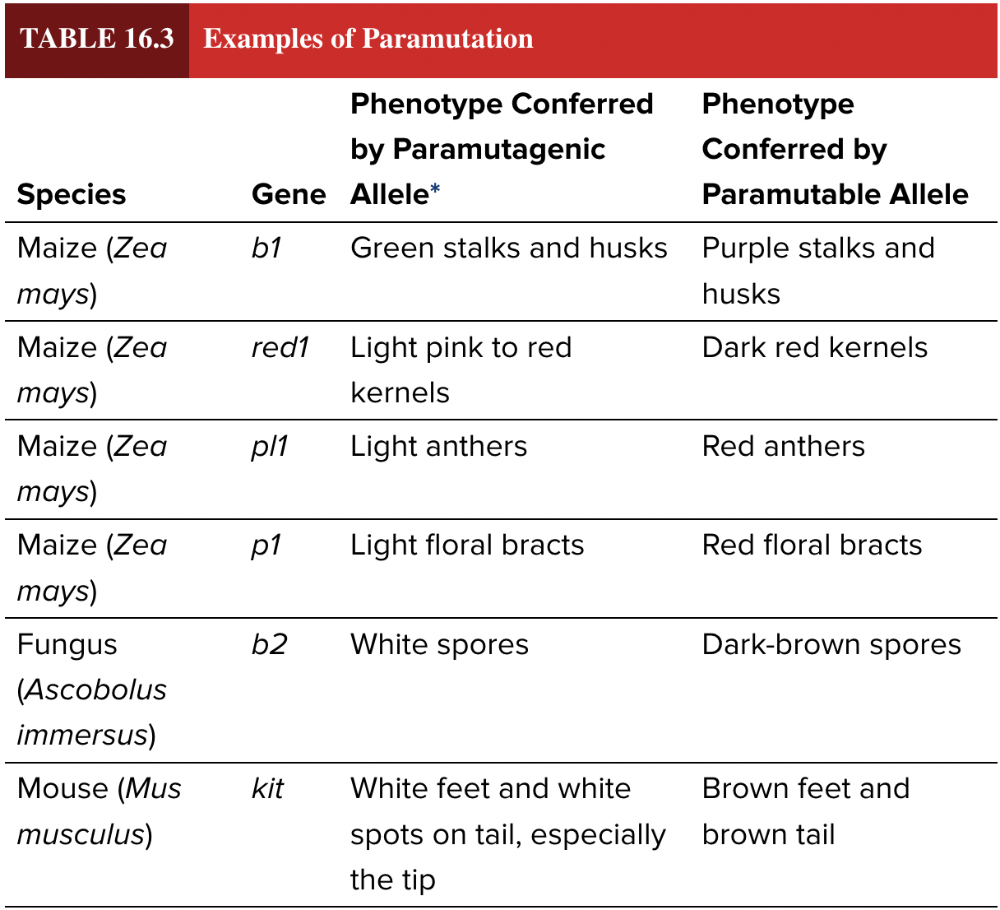
green
In maize, the red1 + allele can change the expression level of red1 allele. The red1 + allele is the ____ allele.
paramutagenic
In mice, the Agouti gene regulates ______.
Multiple choice question.
the deposition of yellow pigment in hair
the sex of mice
the size of mice
the transcription of cell cycling proteins
the deposition of yellow pigment in hair
In maize, the dominant allele B-I codes for a transcription factor that regulates genes involved in producing purple color in corn stalks and husks. The allele can undergo a mutation to B' which changes the stalk and husk color from purple to green. In a cross between B-I B-I and B' B' homozygotes, the F1 heterozygotes all have green stalks and husks. When these F1 individuals are crossed to B-I B-I homozygotes, all of the F2 offspring have green stalks and husks. The results for the F2 generation demonstrate a ______ paramutation of the ______ allele.
Multiple choice question.
secondary; B-I allele.
secondary; B' allele.
primary; B-I allele.
primary; B' allele.
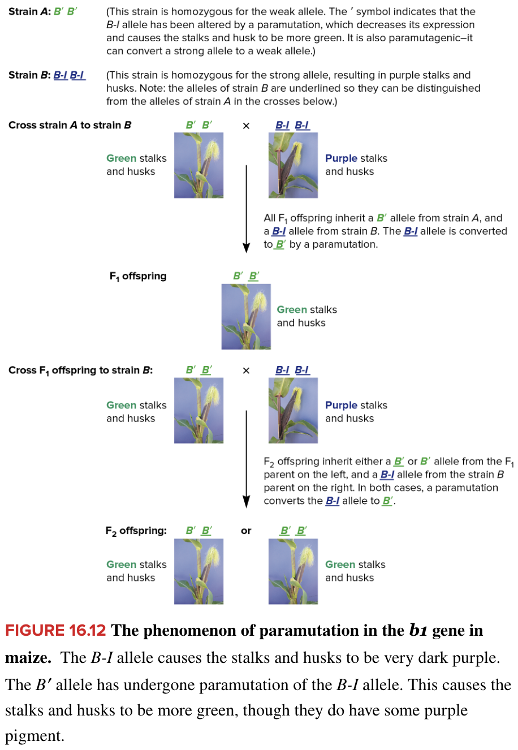
secondary; B-I allele.
Mice that are homozygous for the loss-of-function mutation in the Agouti gene will have ______ fur.
Multiple choice question.
yellow
black
brown
white
black
Reason:
A yellow band in each hair shaft is due to a dominant rather than a recessive allele.
When a paramutation is passed down for several generations and continues to affect the expression of other alleles in each generation, this is known as ______.
Multiple choice question.
permanent paramutation
stable paramutation
secondary paramutation
frequent paramutation
secondary paramutation
Reason:
There is a more specific term for this type (stable paramutation) of paramutation.
Multiple tandem repeat sequences near paramutagenic alleles may be involved in paramutation by ______.
Multiple choice question.
binding many transcription factors to increase expression
causing gene duplication to increase expression
producing siRNAs to reduce expression
causing frameshifts to alter the protein
producing siRNAs to reduce expression
When there is a gain-of-function mutation in the mouse Agouti gene, the gene is ______ resulting in ______.
Multiple choice question.
not expressed; white fur
over-expressed; black fur
expressed normally; wild-type brown fur with black tips
over-expressed; yellow fur
over-expressed; yellow fur
Adult, wild-type mice with genotype AA for the Agouti gene will have what color coat hairs?
Multiple choice question.
All black
Yellow with brown tips
All yellow
All brown
Brown with black tips
Brown with black tips
Reason:
The yellow pigment is sandwiched between layers of black pigment, giving a brown color along most of the hair shaft. No yellow pigment is synthesized near the tip of the hair.
Reason:
No yellow pigment is synthesized near the tips of the hairs, so the tips will be black.
What accounts for the wide array of coat colors seen in mice carrying the A vy allele of the Agouti gene?
Multiple choice question.
Mutation of the Agouti gene that regulates coat color
Trimethylation of the Agouti gene that regulates coat color
Epigenetic modification of the promoter in the transposable element responsible for over expressing the Agouti gene
Variable duplication of the Agouti gene so that increasing copy number leads to lighter coloration
Epigenetic modification of the promoter in the transposable element responsible for over expressing the Agouti gene
Mice that are homozygous for the loss-of-function mutation in the Agouti gene will have black fur because ______.
Multiple choice question.
melanin is not produced
the mice are albino
pheomelanin is not produced
pheomelanin is not produced
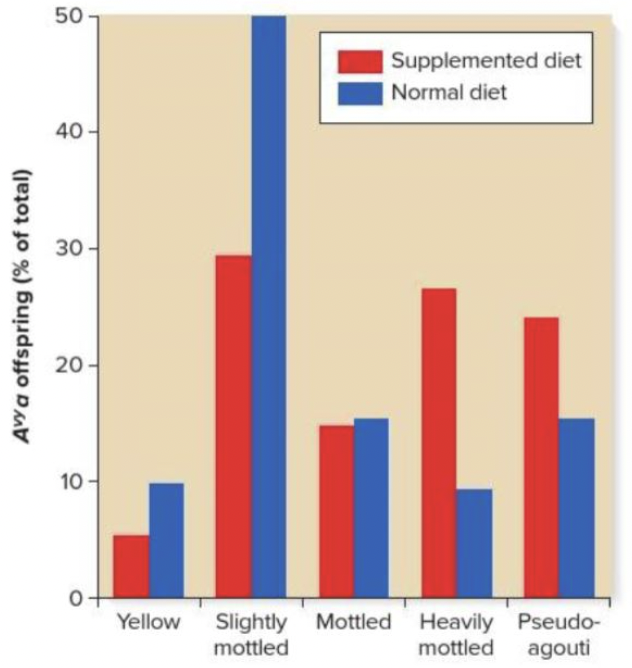
What can be deduced about the environmental effect of diet on expression of the Agouti gene?
Multiple choice question.
Offspring of females fed a supplemental diet exhibited the same color coat as the parents.
Offspring of females fed a supplemental diet had darker coats.
Offspring of females fed a supplemental diet had lighter coats.
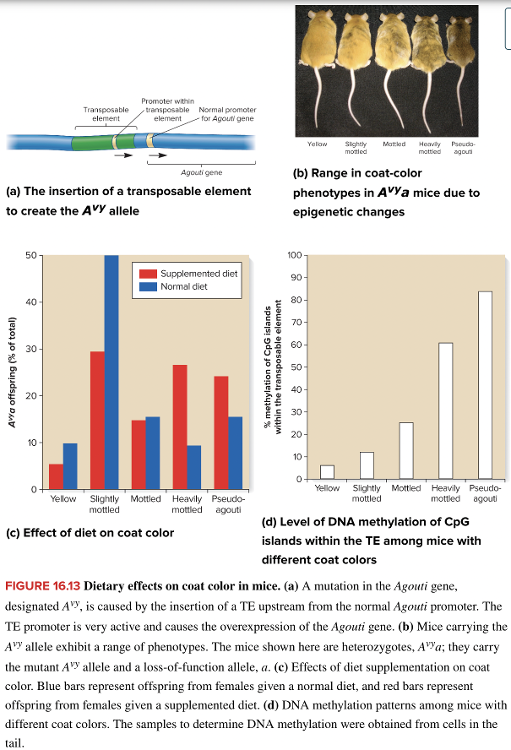
Offspring of females fed a supplemental diet had darker coats.
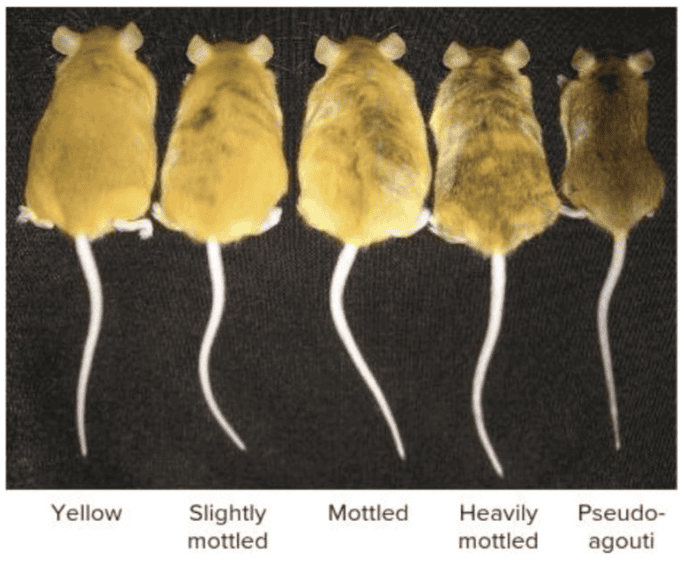
What accounts for the variation in coat color in the mice shown?
Multiple choice question.
Mutation within the coding region of the Agouti gene
Degree of methylation at CpG islands in the TE upstream from the Agouti gene
Degree of methylation within the Agouti gene
Mutation in the promoter of the Agouti gene

Degree of methylation at CpG islands in the TE upstream from the Agouti gene
Reason:
All of the pictured mice carry the A vy allele for the Agouti gene
Reason:
Methylation of a region in the promoter, upstream of the gene, affects the level of coat color expression.
Mice with a gain-of-function mutation in the Agouti gene will have ______ fur.
Multiple choice question.
black
brown
white
yellow
yellow
Female honeybee larvae fed royal jelly during early development, and nectar or pollen later in development will become ______ bees.
Multiple choice question.
worker
queen
worker
Reason:
Queen bees need to be consistently fed on royal jelly.
Mice with the A vy allele exhibit ______.
Multiple choice question.
completely white fur
completely black fur
a wide array of coat colors
a wide array of coat colors
Reason:
The transposable element associated with this allele appears to be sensitive to epigenetic modifications.

What conclusion can be made regarding the environmental effect of diet on the expression of the Agouti gene?
Multiple choice question.
The supplemental diet influenced the expression of the Agouti gene.
The supplemental diet had no effect on the expression of the Agouti gene.

The supplemental diet influenced the expression of the Agouti gene.
The annual flowering plant Arabidopsis thaliana has two different types. Only the ______ require vernalization for flowering.
Multiple choice question.
summer-annuals, which grow from spring to fall,
winter annuals, which grow from fall to spring,
winter annuals, which grow from fall to spring,
Which transcription factors activate several genes that lead to flower development in the winter-annual type of Arabidopsis?
Multiple choice question.
VIN3 and COLDAIR
FT and FLC
FLC and SOC1
VRN1 and VRN2
FT and SOC1
FLC and SOC1
Reason:
Transcription of SOC1 is activated by another gene.
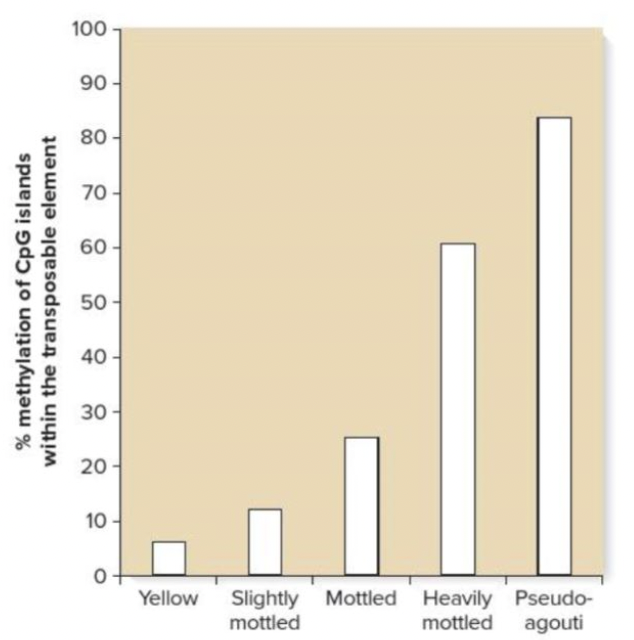
What can be deduced about the effect of DNA methylation levels on expression of the Agouti gene?
Multiple choice question.
Greater levels of methylation had no affect on coat color.
Greater levels of methylation resulted in lighter coat color.
Greater levels of methylation resulted in darker coat color.

Greater levels of methylation resulted in darker coat color.
Female honeybee larvae fed and bathed in royal jelly during development will become ______ bees.
Multiple choice question.
queen
worker
queen
What accounts for the wide array of coat colors seen in mice carrying the A vy allele of the Agouti gene?
Multiple choice question.
Epigenetic modification of the promoter in the transposable element responsible for over expressing the Agouti gene
Mutation of the Agouti gene that regulates coat color
Variable duplication of the Agouti gene so that increasing copy number leads to lighter coloration
Trimethylation of the Agouti gene that regulates coat color
Epigenetic modification of the promoter in the transposable element responsible for over expressing the Agouti gene
Click and drag on elements in order
Order the steps in the regulation of FLC expression by exposure to cold temperatures, putting the first step at the top.
VIN3/PRC2 complex binds to COLDAIR RNA as it is transcribed from within an FLC intron
VIN3 protein and PRC2 form a complex
VIN3/PRC2 complex methylates histone H3 within the FLC gene
Prolonged cold induces expression of VIN3 and COLDAIR
FLC gene expression is repressed
1. Prolonged cold induces expression of VIN3 and COLD AIR
2. VIN3 protein and PRC2 form a complex
3. VIN3/PRC2 complex binds to COLDAIR RNA as it is transcribed from within an FLC intron
4. VIN3/PRC2 complex methylates histone H3 within the FLC gene
5. FLC gene expression is repressed
Select all that apply
After vernalization, plants ______.
Multiple select question.
have acquired epigenetic modifications in their genome.
immediately begin flowering.
have the ability to flower when conditions are favorable.
have acquired mutations in their genome.
have acquired epigenetic modifications in their genome.
have the ability to flower when conditions are favorable.
The protein ______ which represses genes required for flowering in the winter-annual type of Arabidopsis, is inhibited by prolonged exposure to cold.
Multiple choice question.
FT
COLDAIR
FLC
VIN3
FLC
Which one best represents the current model of how cold temperatures cause repression of the FLC gene?
Multiple choice question.
Cold temperatures inhibit the expression of a transcription factor that represses FLC
Cold temperatures induce expression of a non-coding RNA, COLDAIR, which recruits a chromatin modifying complex to FLC
The transcription factor FT is unable to bind to the FLC promoter in cold temperature
Cold temperatures cause an overall decrease in plant gene expression
Cold temperatures induce expression of a non-coding RNA, COLDAIR, which recruits a chromatin modifying complex to FLC
